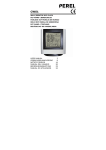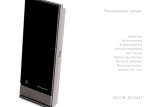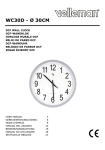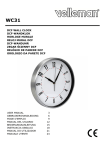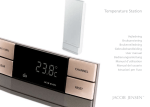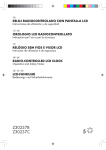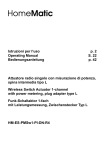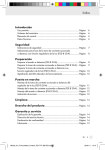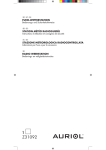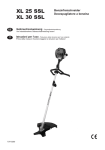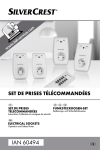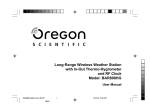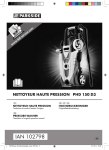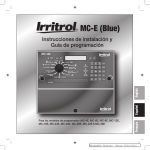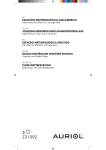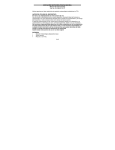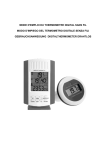Download Z31055A Z31055B - Lidl Service Website
Transcript
E STACIÓN DE TEMPERATURA I nstrucciones de utilización y de seguridad STAZIONE TERMOMETRICA I ndicazioni per l’uso e per la sicurezza M EDIDOR DE TEMPERATURA I nstruções de utilização e de segurança TEMPERATURE STATION O peration and Safety Notes TEMPERATURSTATION B edienungs- und Sicherheitshinweise 5 31055A Z Z31055B ESInstrucciones de utilización y de seguridad Página IT / MTIndicazioni per l’uso e per la sicurezza Pagina 26 6 PTInstruções de utilização e de segurança Página 47 GB / MT Page Operation and Safety Notes DE / AT / CHBedienungs- und Sicherheitshinweise 68 Seite87 A 17 1 2 3 4 5 6 7 8 16 9 15 10 14 11 13 12 3 B 18 19 22 21 20 x 1 C 23 24 25 27 x 1 4 26 x 1 D 28 x 1 E 29 30 32 x 1 31 x 1 5 Uso adecuado................................... Página7 Descripción de los elementos... Página7 Datos técnicos.................................... Página8 Seguridad Indicaciones generales de seguridad...... Página9 Indicaciones de seguridad sobre las pilas.... Página10 Antes de la puesta en marcha Indicaciones generales............................. Página11 Puesta en marcha del sensor exterior...... Página12 Puesta en funcionamiento de la estación meteorológica............................................ Página13 Estación meteorológica............................. Página15 Sensor exterior........................................... Página15 Ajuste manual de idioma / zona horaria / hora / fecha...................... Página16 Visualización del horario de verano........ Página17 Visualizar la zona horaria........................ Página18 Ajuste de la alarma................................... Página18 Consultar alarmas..................................... Página19 Conexión y desconexión de la alarma.... Página19 Uso de la función de retraso de alarma.... Página20 Indicación de la temperatura................... Página20 Consultar valores máximos / mínimos...... Página20 Visualizar la tendencia de temperatura.... Página21 Indicación de estado de las pilas............ Página21 Cambiar pilas............................................ Página21 Corregir errores............................... Página22 Limpieza y mantenimiento.... Página23 Eliminación........................................... Página23 Declaración de conformidad.... Página24 6 ES Estación de temperatura Uso adecuado La estación meteorológica muestra la temperatura interior y exterior en grados Celsius (ºC) o Fahrenheit (ºF), así como sus valores máximos y mínimos. La estación meteorológica también muestra la hora con formato de 12 / 24 horas y la fecha. La estación meteorológica también dispone de función de alarma. Este aparato no ha sido diseñado para uso industrial. Descripción de los elementos Pantalla LCD 1 Tendencia de temperatura (temperatura exterior) 2 Temperatura exterior 3 -Símbolo (sensor exterior) 4 Indicación MAX / MIN para temperatura interior 5 Tendencia de temperatura (temperatura interior) 6 Temperatura interior 7 - Símbolo (estación meteorológica) 8 Hora 9 Símbolo ZZ (función de repetición de alarma) 10 Indicación de segundos 11 -Símbolo 12 Indicación de día de la semana 13 Indicación de la fecha (día / mes) 14 Indicación DST (horario de verano) 15 / -símbolo (alarma 1 / alarma 2) ES 7 16 Segunda zona horaria (ZONE) 17 Indicación MAX / MIN (temperatura exterior) Estación meteorológica 18 Tecla ZZ / REGISTER (función de repetición de alarma / REGISTRER) 19 Tecla SELECT (“seleccionar”) 20 Tecla SET / RESET (“ajustar” / “resetear”) 21 Tecla ALARM 22 Tecla CLOCK (hora) 23 Dispositivo para colgar 24 Compartimento de las pilas 25 Soporte vertical 26 Tornillo (ø 3 mm) 27 Taco (ø 7 mm) Sensor exterior 28 LED de control 29 Dispositivo para colgar 30 Compartimento de las pilas 31 Tornillo (ø 3 mm) 32 Taco (ø 7 mm) Datos técnicos Estación meteorológica: Rango de temperaturas:0 – + 50 °C +32 – +122 °F Nota: Si la temperatura es inferior a 0 °C (32 °F) se mostrará “LL.L”. Si la temperatura es superior a 50 °C (122 °F) se mostrará “HH.H”. Resolución de temperatura:0,1 °C Señal de radiofrecuencia: DCF 8 ES Pilas:2 x AA 1,5 V (incluidas en el volumen de suministro) Sensor exterior: Rango de temperaturas: –20 °C – +60 °C –4 °F – +140 °F Nota: Si la temperatura es inferior a –20 °C (–4 °F) se mostrará “LL.L”. Si la temperatura es superior a 60 °C (140 °F) se mostrará “HH.H”. Señal de transmisión HF: 433 MHz Alcance de transmisión HF:máx. 30 metros en terreno sin obstáculos Pilas:2 x AA 1,5 V (incluidas en el volumen de suministro) Seguridad ¡GUARDAR TODAS LAS ADVERTENCIAS E INDICACIONES DE SEGURIDAD POR SI LAS NECESITA EN UN FUTURO! Indicaciones generales de seguridad L os niños o las personas que carezcan de los conocimientos o la experiencia necesarios para manipular el aparato o aquellas cuyas capacidades físicas, sensoriales o psicológicas estén limitadas, no deben utilizar el aparato sin la supervisión o las indicaciones de ES 9 una persona responsable por su seguridad. Debe mantenerse a los niños vigilados para que no jueguen con el aparato. El producto no es un juguete. No exponga el aparato a campos electromagnéticos extremadamente elevados. Esto podría afectar al funcionamiento del aparato. Tenga en cuenta que los daños producidos por manejo incorrecto, no seguimiento del manual de instrucciones o manipulación por parte de personas no autorizadas, están excluidos de la garantía. Indicaciones de seguridad sobre las pilas ¡PELIGRO DE MUERTE! Las pilas podrían ser ingeridas, lo cual comporta un riesgo mortal. En caso de ingestión de una pila, habrá que solicitar asistencia médica inmediatamente. Retire las pilas del aparato si no piensa utilizarlo durante un período de tiempo prolongado. ¡PRECAUCIÓN! ¡PELIGRO DE EXPLOSIÓN! No recargue nunca pilas no recargables. ¡Cuando coloque las pilas observe la polaridad correcta! Ésta se indica en el compartimento de las baterías. Retire inmediatamente las pilas agotadas del aparato. ¡Existe alto peligro de derrame de sustancias interiores! 10 ES M antenga las pilas fuera del alcance de los niños. No las arroje al fuego, no las ponga en cortocircuito y no las desmonte. Reemplace todas las baterías a la vez. Utilice únicamente pilas del mismo tipo. En caso contrario existe peligro de explosión. ¡Si se derrama el líquido de las pilas dentro del aparato, sáquelas inmediatamente para evitar daños en el aparato! Evite el contacto con la piel, ojos y mucosas. Si se entra en contacto con el ácido de las baterías, lave la parte afectada con abundante agua y / o procure atención médica. Antes de la puesta en marcha Emplace primero la pila en el sensor externo y después en la estación meteorológica. Indicaciones generales ¡PRECAUCIÓN! Al elegir un lugar donde colocar los dispositivos, asegúrese de que éstos no están expuestos directamente a radiaciones solares, vibraciones, polvo, calor, frío o humedad. No sitúe los aparatos cerca de fuentes de calor (p. ej. radiadores). De hacerlo podrían sufrir daños. Coloque la estación meteorológica sobre el soporte vertical correspondiente 25 . Asegúrese de que los aparatos adyacentes no utilicen la misma frecuencia de 433 MHz. ES 11 Estos aparatos pueden alterar la comunicación inalámbrica. No coloque los aparatos cerca o encima de placas de metal. La transmisión inalámbrica entre los dispositivos podría verse alterada. Señal de radiofrecuencia (DCF): La señal DCF (emisor de señal horaria) consiste en impulsos horarios emitidos por uno de los relojes más precisos del mundo, cerca de Francfort del Meno, Alemania, que tiene una desviación de 1 segundo en 1 millón de años. Su estación meteorológica recibe esta señal en condiciones perfectas hasta una distancia de aprox. 1.500 km. alrededor de Francfort del Meno. Puesta en marcha del sensor exterior Colocación de las pilas: Retire la tapa del compartimento de las pilas en la parte trasera del sensor exterior. Coloque dos pilas de 1,5 V AA (incluidas en el volumen de suministro) en el compartimento de las pilas 30 . Nota: Tenga en cuenta la polaridad correcta. Ésta se indica en el compartimento de las pilas. El sensor exterior ya está listo para funcionar y el LED de control 28 se ilumina brevemente. Cierre la cubierta del compartimento de las pilas. 12 ES Puesta en funcionamiento de la estación meteorológica Colocación de las pilas: Abra la tapa del compartimento de las pilas 24 en la parte trasera de la estación meteorológica. Coloque dos pilas de 1,5 V AA (incluidas en el volumen de suministro) en el compartimento de las pilas. Nota: tenga en cuenta la polaridad correcta. Ésta se indica en el compartimento de las pilas (véase también fig. C + E). Cierre la cubierta del compartimento de las pilas. Conectar la estación meteorológica con el sensor externo y la señal de radiofrecuencia DCF: Tras insertar las pilas, la estación meteorológica intenta establecer conexión con el sensor exterior. Este proceso puede durar algunos minutos. El símbolo parpadea. En cuanto se produce la conexión, el símbolo deja de parpadear y la temperatura se muestra en la pantalla LCD. Nota: si la estación meteorológica no recibe la señal del sensor exterior al cabo de 3 minutos, la estación meteorológica inicia entonces automáticamente la recepción de la señal de radiofrecuencia. La estación meteorológica inicia la recepción de la señal de radiofrecuencia una vez recibida la señal exterior o al cabo de 3 minutos. Este proceso ES 13 puede durar hasta 5 minutos, durante el cual el símbolo 11 parpadea en la pantalla LCD. Una vez recibida correctamente la señal de radiofrecuencia DCF se muestra permanentemente el símbolo en la pantalla LCD. Nota: Durante la recepción de la señal no cambie la estación meteorológica de lugar. De lo contrario podrían producirse fallos durante la recepción. Si en el momento de la puesta en servicio no se puede establecer conexión con el reloj atómico, cambie la ubicación de la estación meteorológica (p.ej. cerca de una ventana). Si fuera necesario, reinicie la estación meteorológica, si ésta no funciona correctamente. Para ello, mantenga pulsada la tecla ZZ / REGISTER 18 . La recepción puede verse considerablemente mermada por ciertos impedimentos (por ej. por paredes de hormigón) o fuentes de distorsión (por ej. otros aparatos eléctricos). Si persiste la dificultad de recepción puede configurar manualmente la fecha y la hora (véase “Ajuste manual de idioma / zona horaria / hora / fechau”). Montaje de la estación meteorológica y / o sensor exterior en la pared: 14 ES Nota: para este paso de trabajo necesita un taladro y un destornillador con punta de estrella. ¡PRECAUCIÓN! ¡PELIGRO MORTAL Y DE LESIONES, ASÍ COMO DAÑOS AL APARATO! Lea también las indicaciones de manejo y seguridad de su taladro. ¡PELIGRO DE MUERTE! Asegúrese de no tocar conductos de agua, gas o electricidad cuando perfore la pared. En caso necesario, realice una comprobación con un buscador de líneas antes de perforar la pared. Estación meteorológica Marque el agujero de perforación (ø aprox. 7 mm) en la pared. Realice el agujero con una taladro. Introduzca el taco 27 en el agujero perforado. Introduzca el tornillo 26 en el taco con un destornillador. Enganche la estación meteorológica con el dispositivo para colgar 23 en el tornillo. Sensor exterior Marque el agujero de perforación (ø aprox. 7 mm) en la pared. Realice el agujero con una taladro. Introduzca el taco 32 en el agujero perforado. Introduzca el tornillo 31 en el taco con un destornillador. Enganche el sensor exterior con el dispositivo para colgar 29 en el tornillo. ES 15 Nota: asegúrese de que el sensor exterior no entre en contacto directo con agua o los rayos solares. Los aparatos electrónicos pueden producir interferencias en la recepción. Ajuste manual de idioma / zona horaria / hora / fecha La recepción de la señal de radiofrecuencia DCF puede alterarse o interrumpirse en el lugar de instalación de la estación meteorológica. En este caso, los ajustes en el aparato se pueden realizar también manualmente. 1.Presione y mantenga presionada la tecla CLOCK 22 durante aprox. 3 segundos. 2.Presione la tecla SET / RESET 20 , para cambiar el formato de la hora (12 o 24 horas). 3.Presione la tecla CLOCK para confirmar la entrada. La indicación de día de la semana 12 parpadea. Consejo: mantenga pulsada la tecla SET / RESET. De este modo podrá ajustar los valores más rápidamente. Este modo de ajuste rápido puede emplearse también para los demás ajustes. Si no presiona ninguna tecla durante 30 segundos, la pantalla LCD regresa automáticamente a la indicación estándar. 4.Pulse la tecla SET / RESET, para ajustar el idioma deseado (GE = alemán, FR = francés, SP = español, IT = italiano, EN = inglés). 16 ES 5.Presione la tecla CLOCK para confirmar la entrada. La indicación de zona horaria parpadea. 6.Pulse la tecla SET / RESET, para configurar la zona horaria deseada para la zona horaria 2 (–12 horas hasta +12 horas). Nota: si se encuentra en un país con recepción de señal DCF, pero con desviación de la hora actual, puede utilizar el ajuste de la zona horaria para ajustar la hora actual. Por ejemplo, si se encuentra en un país en el que la hora local es una hora más temprana que la hora centroeuropea (MEZ), ajuste la zona horaria a +01. La hora sigue siendo controlada mediante DCF, pero se mostrará una hora más. Por ejemplo, si desea saber qué hora es en los EE.UU., ajuste la zona horaria a –10 para la hora local de Los Ángeles, etc. 7.Presione la tecla CLOCK para confirmar la entrada. El indicador de horas parpadea. 8.Pulse la tecla SET / RESET para ajustar el valor deseado. 9.Presione la tecla CLOCK para confirmar la entrada. 10.Repita los pasos 6 y 7 para ajustar los valores de minutos, segundos 10 , año y fecha 13 (día / mes). Nota: La indicación de segundos sólo se puede resetear a 00. 11.La pantalla LCD regresa a continuación nuevamente al modo estándar. ES 17 Visualización del horario de verano El horario de verano se muestra automáticamente en la pantalla LCD con el símbolo DST 14 . La estación meteorológica reconoce automáticamente a través de la señal DCF el horario de verano. Visualizar la zona horaria En la visualización estándar se muestra la zona horaria según la señal DCF. Pulse la tecla CLOCK 22 . La segunda zona horaria 16 se muestra en la pantalla. Pulse nuevamente la tecla CLOCK, para regresar a la visualización estándar. Ajuste de la alarma Puede ajustar 2 horas de alarma diferentes. 1.Presione y mantenga presionada la tecla ALARM 21 durante aprox. 3 segundos. Nota: Si se ha programado previamente una alarma, ésta se mostrará en la pantalla. De lo contrario se muestra 0:00 o AM 12:00. 2.El indicador de las horas parpadea. Pulse la tecla SET / RESET 20 para ajustar el valor deseado. 3.Presione la tecla ALARM para confirmar su entrada. El indicador de minutos parpadea. 4.Pulse la tecla SET / RESET para ajustar el valor deseado. 18 ES 5.Presione la tecla ALARM para confirmar su entrada. 6.Repita los pasos 2 a 5 para programar la alarma 2. Consultar alarmas Pulse 1 o 2 veces la tecla ALARM 21 para consultar la hora de la alarma 1 o de la alarma 2. Pulse nuevamente la tecla ALARM para regresar a la visualización estándar. Conexión y desconexión de la alarma Pulse una vez la tecla SET / RESET 20 para activar la alarma 1. Pulse 2 veces la tecla SET / RESET para activar la alarma 2. Pulse tres veces la tecla SET / RESET para activar las alarmas 1 y 2. Nota: El símbolo o aparece en la pantalla LCD. La señal de alarma suena al alcanzarse la hora ajustada. Al cabo de 2 minutos se apaga la señal de alarma automáticamente. Pulse la tecla ALARM 21 para apagar la señal alarma antes de tiempo. Nota: la alarma se activa cada día a la hora programada. Pulse la tecla SET / RESET 3 veces para desactivar la alarma 1. Pulse la tecla SET / RESET 2 veces para desactivar la alarma 2. Pulse la tecla SET / RESET 1 vez para desactivar las alarmas 1 y 2. ES 19 Uso de la función de retraso de alarma Presione la tecla ZZ / REGISTER 18 para activar la función de retraso de la alarma. La alarma enmudece y las indicaciones o y ZZ parpadean. La señal de alarma se repite al cabo de aprox. 5 minutos. Pulse la tecla SELECT 19 para desactivar la función de retraso de la alarma. Indicación de la temperatura La pantalla LCD muestra tanto la temperatura interior 6 como la exterior 2 . Presione y mantenga presionada la tecla SELECT 19 durante aprox. 3 segundos. La indicación °C parpadea. Pulse la tecla SET / RESET 20 , para cambiar entre las escalas de temperatura °C (Celsius) y °F (Fahrenheit). Presione la tecla SELECT para confirmar la entrada. Consultar valores máximos / mínimos La estación meteorológica guarda los valores máximo y mínimo del sensor exterior y de la propia estación. Pulse la tecla SELECT 19 para visualizar los valores máximos de la temperatura interior 4 y exterior 17 . 20 ES Pulse la tecla SELECT para visualizar los valores mínimos de la temperatura interior y exterior. Pulse la tecla SET / RESET 20 mientras se muestran los valores máximo y mínimo para resetear los valores. Pulse la tecla SELECT para regresar a la visualización estándar. Visualizar la tendencia de temperatura Una vez establecida correctamente la conexión con el sensor exterior se muestra la tendencia de temperatura (exterior) 1 , así como la tendencia de temperatura (interior) 5 . Se pueden observar las siguientes indicaciones: = La temperatura aumenta. = La temperatura permanece constante. = La temperatura disminuye. Indicación de estado de las pilas 3 y 7 se muestran en la Los símbolos pantalla LCD de la estación meteorológica cuando el nivel de las pilas del sensor externo o de la estación es bajo. Cambiar pilas Abra el compartimento de las pilas 24 o 30 . Retire las pilas gastadas. Inserte dos pilas nuevas de 1,5 V (AA) en el compartimento. ES 21 Nota: Tenga en cuenta la polaridad correcta. Ésta se indica en el compartimento de las pilas (véase también fig. C + E). Cierre el compartimento de las pilas. Corregir errores Nota: el aparato contiene componentes electrónicos. No coloque el aparato cerca de fuentes de interferencias como teléfonos móviles, aparatos de radiotransmisión, emisoras de banda ciudadana, mandos a distancia o microondas, etc. Retire este tipo de aparatos del alcance de la estación meteorológica / del sensor exterior, o retire brevemente las baterías de la estación meteorológica / del sensor exterior, cuando la pantalla muestre averías. La recepción se puede reducir considerablemente por algunos obstáculos, p.ej. paredes de hormigón. En este caso, cambie la ubicación de la estación (p.ej. cerca de la ventana). Tenga en cuenta que el sensor exterior tiene que colocarse siempre a un radio máximo de 30 metros (campo libre) de la estación base. El rango especificado es el rango a campo libre y significa que no tiene que haber ningún obstáculo entre el sensor externo y la estación base. Un „contacto visual“ entre el sensor exterior y la estación base a menudo mejora la transmisión. 22 ES El frío (temperaturas exteriores bajo 0°C) pueden reducir el rendimiento de las pilas del sensor exterior y, en consecuencia, perjudicar la radio transmisión. Las pilas gastadas o casi vacías son otro factor que puede perjudicar a la recepción del sensor externo. Cámbielas por pilas nuevas. Si la estación meteorólogica no funciona bien, retire las pilas durante un momento y a continuación póngalas de nuevo. Limpieza y mantenimiento Limpie el aparato sólo por fuera con un paño suave y seco. No proyecte agua hacia el sensor exterior bajo ninguna circunstancia, p.ej. con la manguera del jardín. El sensor exterior solamente está protegido contra la lluvia por la parte superior. Eliminación E l embalaje se compone de materiales reciclables que puede desechar en los puntos locales de recogida selectiva. Puede consultar las posibilidades de eliminación del producto usado en la administración de su comunidad o ciudad. ES 23 P ara proteger el medioambiente, cuando ya no utilice el aparato, no lo arroje a la basura doméstica, sino deséchelo adecuadamente. Diríjase a la administración competente para obtener información sobre los puntos de recogida de desechos y sus horarios. Las pilas defectuosas o usadas deben ser recicladas según lo indicado en la directiva 2006 / 66 / EC. Devuelva las pilas y / o el aparato a través de los puntos de recogida indicados. Pb Hg Daños medioambientales debidos a un reciclaje incorrecto de las pilas Las pilas no deben eliminarse junto a los residuos domésticos. Pueden contener metales pesados tóxicos que deben tratarse conforme a la normativa aplicable a los residuos especiales. Los símbolo químicos de los metales pesados son: Cd = cadmio, Hg = mercurio, Pb = plomo. Las pilas deben reciclarse en el punto de recolección específico para ello. Declaración de conformidad Nosotros OWIM GmbH & Co. KG, Stiftsbergstraße 1, D-74167 Neckarsulm, declaramos en responsabilidad única que el producto: Estación de temperatura, modelo n.° Z31055 A / Z31055B, versión: 09 / 2012, al que esta declaración hace 24 ES referencia, cumple con todas las normas / y la normativa de los documentos de 1999 / 5 / EC. La declaración de conformidad completa puede ser consultada en la página: www.owim.com EMC ES 25 Utilizzo conforme alla destinazione d’uso........................ Pagina27 Descrizione dei componenti.... Pagina27 Dati tecnici............................................. Pagina29 Sicurezza Avvisi di sicurezza generali...................... Pagina30 Avvertenze di sicurezza sulle batterie...... Pagina30 Prima della messa in funzione Avvertenze generali.................................. Pagina32 Messa in funzione del sensore esterno.... Pagina33 Messa in funzione della stazione meteo.... Pagina33 Stazione meteo.......................................... Pagina36 Sensore esterno......................................... Pagina36 Impostazione manuale di lingua / fuso orario / orario / data......................... Pagina37 Visualizzazione dell’ora legale................ Pagina39 Attivazione del fuso orario........................ Pagina39 Impostazione dell’allarme......................... Pagina39 Richiamo degli orari di allarme................ Pagina40 Inserzione / disinserzione dell‘allarme..... Pagina40 Utilizzo della funzione di ripetizione della suoneria............................................ Pagina41 Visualizzazione della temperatura........... Pagina41 Richiamo dei valori minimi e massimi....... Pagina42 Visualizzazione della tendenza di temperatura................................................ Pagina42 Visualizzazione delle batterie................... Pagina43 Sostituzione delle batterie......................... Pagina43 Eliminazione dei guasti............. Pagina43 Pulizia e manutenzione............ Pagina44 Smaltimento........................................ Pagina45 Dichiarazione di conformità.... Pagina46 26 IT/MT Stazione termometrica Utilizzo conforme alla destinazione d’uso La stazione meteo visualizza la temperatura interna ed esterna espressa in gradi Celsius (°C) oppure in gradi Fahrenheit (°F), nonché i loro valori minimi e massimi. La stazione meteo visualizza inoltre l’orario in formato 12 / 24 ore nonché la data. Inoltre la stazione meteo dispone di una funzione di allarme. L’apparecchio non è destinato a un utilizzo in ambito commerciale. Descrizione dei componenti Display a cristalli liquidi 1 Tendenza della temperatura (temperatura esterna) 2 Temperatura esterna 3 Simbolo (sensore esterno) 4 Visualizzazione MAX / MIN per la temperatura interna 5 Tendenza della temperatura (temperatura interna) 6 Temperatura interna 7 Simbolo (stazione meteo) 8 Orario 9 Simbolo ZZ (funzione SNOOZE - di ripetizione dell’allarme) 10 Visualizzazione dei secondi 11 Simbolo 12 Visualizzazione del giorno della settimana IT/MT 27 13 Data (die / mese) 14 Visualizzazione DST (ora legale) 15 Simbolo / (Allarme 1 / Allarme 2) 16 2. Fuso orario (ZONE) 17 Visualizzazione MAX / MIN (temperatura esterna) Stazione meteo 18 Tasto ZZ / REGISTER (funzione di ripetizione dell’allarme / REGISTRO) 19 Tasto SELECT (“selezione”) 20 Tasto SET / RESET (“impostazione” / “ azzeramento”) 21 Tasto ALARM 22 Tasto CLOCK (orario) 23 Dispositivo di aggancio 24 Vano batterie 25 Base 26 Vite (ø 3 mm) 27 Tassello (ø 7 mm) Sensore esterno 28 LED di controllo 29 Dispositivo di aggancio 30 Vano batterie 31 Vite (ø 3 mm) 32 Tassello (ø 7 mm) 28 IT/MT Dati tecnici Stazione meteo: Campo di misurazione della temperatura:0 – + 50 °C +32 – +122 °F Consiglio: Se la temperatura è minore di 0 °C (32 °F), viene visualizzato „LL.L“. Se la temperatura è maggiore di 50 °C (122 °F), viene visualizzato „HH.H“. Arrotondamento temperatura: 0,1 °C Segnale radio: DCF Batterie:2 x AA 1,5 V (incluse nella fornitura) Sensore esterno: Campo di misurazione della temperatura: –20 °C – + 60 °C –4 °F – +140 °F Consiglio: Se la temperatura è minore di – 20 °C (– 4 °F), viene visualizzato „LL.L“. Se la temperatura è maggiore di 60 °C (140 °F), viene visualizzato „HH.H“. Segnale di trasmissione ad alta frequenza: 433 MHz Area di copertura della trasmissione ad alta frequenza:max. 30 metri in campo aperto Batterie:2 x AA 1,5 V (incluse nella fornitura) IT/MT 29 Sicurezza CONSERVARE TUTTE LE AVVERTENZE DI SICUREZZA E LE ISTRUZIONI PER UN EVENTUALE USO FUTURO! vvisi di sicurezza A generali B ambini o persone, cui mancano conoscenza o esperienza nel maneggiare l’apparecchio, o le cui capacità fisiche, sensoriali o psichiche sono limitate, non devono utilizzare l’apparecchio senza sorveglianza o guida di una persona responsabile della loro sicurezza. E’ necessario sorvegliare i bambini affinché non giochino con questo prodotto. Il prodotto non è un giocattolo. Non esporre l’apparecchiatura ad un campo magnetico di alta intensità. Ciò potrebbe limitare la funzionalità dell’apparecchiatura. Prendere in considerazione il fatto che i danneggiamenti ad opera di maneggio scorretto, violazione delle istruzioni d’uso e causati da interventi di personale non autorizzato sono esclusi dalla garanzia. vvertenze di sicurezza A sulle batterie PERICOLO DI MORTE! L‘ingerimento delle batterie può essere 30 IT/MT mortale. Qualora una batteria sia stata ingerita, rivolgersi immediatamente ad un medico. Rimuovere dall’apparecchio le batterie non utilizzate per parecchio tempo. PRUDENZA! PERICOLO DI ESPLOSIONE! Non ricaricare mai batterie non ricaricabili. Prestare attenzione alla polarità corretta quando vengono inserite le batterie! La polarità è riportata nei vani portabatterie. Rimuovere immediatamente le batterie esauste dall’apparecchio. Sussiste ingente pericolo di perdite! Tenere le batterie lontano dalla portata dei bambini, non gettarle nel fuoco, non cortocircuitarle e non smontarle. Sostituire sempre tutte le batterie contemporaneamente. Utilizzare solamente batterie dello stesso tipo. In caso contrario sussiste il pericolo di esplosione. Se le batterie del vostro apparecchio dovessero aver perso dell’acido, estrarle immediatamente al fine di evitare danni all’apparecchio! Evitare il contatto con pelle, occhi e mucose. In caso di contatto con l’acido della batteria sciacquare abbondantemente il punto interessato e / o rivolgersi alle cure mediche! IT/MT 31 Prima della messa in funzione Inserire le batterie prima nel sensore esterno e successivamente nella stazione meteorologica. Avvertenze generali PRUDENZA! Quando sceglie il luogo di posizionamento, si assicuri che le apparecchiature non siano esposte ad insolazione diretta, a vibrazioni, polvere, calore, freddo ed umidità. Non posizionare le apparecchiature vicino a fonti di calore quali ad es. termosifoni. Altrimenti si rischia di danneggiare le apparecchiature. Posizionare la stazione meteo sull’apposito piedino 25 . Assicurarsi che le apparecchiature adiacenti non vengano messe in funzione con la stessa frequenza di 433 MHz. Queste apparecchiature potrebbero causare un disturbo del collegamento radio. Non posizionare le apparecchiature vicino o su piastre di metallo. La trasmissione radio tra le apparecchiature potrebbe essere diminuita. Segnale radio (DCF): Il segnale DCF (trasmettitore dell‘orario) è costituito da impulsi di orari trasmessi da uno degli orologi più esatti del mondo, situato nelle vicinanze di Francoforte sul Meno (Frankfurt / Main) in Germania – subisce una variazioni di un solo secondo nell’arco di in un milione di anni. 32 IT/MT La stazione meteo acquistata riceve questo segnale in condizioni ottimali fino ad una distanza di circa 1.500 km da Francoforte sul Meno. Messa in funzione del sensore esterno Inserimento delle batterie: Rimuovere il coperchio del vano portabatterie posto sul retro del sensore esterno. Inserire due batterie da 1,5 V di tipo AA (incluse nella fornitura) nel vano porta batterie 30 . Nota: Assicurarsi che la polarità sia corretta. La polarità è riportata nel vano portabatterie. Ora il sensore esterno è pronto per essere messo in funzione e il LED di controllo 28 si accende brevemente. Chiudere il coperchio del vano portabatterie. Messa in funzione della stazione meteo Inserimento delle batterie: Aprire il vano portabatterie 24 posto sul retro della stazione meteo. Inserire due batterie da 1,5 V di tipo AA (incluse nella fornitura) nel vano portabatterie. Nota: Assicurarsi che la polarità sia corretta. Questa viene indicata nel vano portabatterie (vedi anche la fig. C + E). Chiudere il coperchio del vano portabatterie. IT/MT 33 Collegamento della stazione meteo con il sensore esterno e il segnale radio DCF: Successivamente all’inserimento delle batterie la stazione meteo cerca di approntare un collegamento con il sensore esterno. Questa procedura può durare alcuni minuti. Il simbolo si illumina. In caso di collegamento instaurato con successo verso il sensore esterno, il simbolo smette di lampeggiare e la temperatura viene visualizzata nel display a cristalli liquidi. Nota: Qualora la stazione meteo non riuscisse a ricevere il segnale del sensore esterno dopo 3 minuti, la stazione meteo avvia automaticamente la ricezione del segnale radio. Una volta ricevuto il segnale del sensore esterno ovvero dopo 3 minuti la stazione meteo avvia la ricezione del segnale radio. Questa procedura può durare fino a 5 minuti e viene visualizzata sul display a cristalli liquidi dal simbolo 11 lampeggiante. Una volta ricevuto il segnale radio DCF il simbolo viene visualizzato sul display a cristalli liquidi in modo costante. Nota: Non modificare la posizione della stazione meteo mentre la procedura di ricezione è in corso. In caso contrario vi possono essere disturbi nella ricezione. Qualora al momento dell’avvio non fosse possibile alcuna sincronizzazione con l’orologio atomico, per prima cosa cambiare la posizione della 34 IT/MT stazione meteo (mettendola ad esempio nei pressi di una finestra). Qualora la stazione meteo non funzionasse più regolarmente, effettuare un nuovo avvio della stessa. A tale scopo, premere e tenere premuto il tasto ZZ / REGISTER 18 . La ricezione può essere notevolmente limitata da ostacoli (ad esempio pareti in calcestruzzo) o da fonti di disturbo (ad esempio altri apparecchi elettrici). Qualora la ricezione del segnale orario continuasse a essere disturbata, è possibile impostare l’orario e la data anche manualmente (vedi il capitolo “Impostazione manuale di lingua / fuso orario / orario / data”). Montaggio della stazione meteo e / o del sensore esterno su una parete: Nota: Per svolgere le operazioni di seguito descritte è necessario utilizzare un trapano ed un cacciavite a croce. PRUDENZA! PERICOLO DI MORTE E DI LESIONI NONCHÉ PERICOLO DI DANNI A COSE! Leggere con attenzione le istruzioni d’uso e di sicurezza del trapano. PERICOLO DI MORTE! Quando si eseguono forature nella parete, assicurarsi di non entrare in contatto con condutture elettriche, idriche o del gas. Se necessario IT/MT 35 controllare la parete con un localizzatore di cavi prima di eseguire un foro. Stazione meteo Contrassegnare il punto dove eseguire il foro (ø ca. 7 mm) sulla parete. Eseguire il foro utilizzando un trapano. Inserire il tassello 27 nel foro eseguito con il trapano. Usando un cacciavite a croce, avvitare la vite 26 nel tassello. Appendere la stazione meteo alla vite con il dispositivo per appendere 23 . Sensore esterno Contrassegnare il punto dove eseguire il foro (ø ca. 7 mm) sulla parete. Eseguire il foro utilizzando un trapano. Inserire il tassello 32 nel foro eseguito con il trapano. Usando un cacciavite a croce, avvitare la vite 31 nel tassello. Appendere il sensore esterno alla vite per mezzo del dispositivo di aggancio 29 . Nota: Assicurarsi che il sensore esterno non venga a contatto diretto con acqua o con la radiazione solare. Gli apparecchi elettronici possono disturbare la ricezione radio. 36 IT/MT Impostazione manuale di lingua / fuso orario / orario / data Nel punto in cui è stata posta la stazione meteo, la ricezione del segnale radio DCF può essere disturbata o interrotta. In questo caso vi è la possibilità di impostare l’apparecchio manualmente. 1.Premere e mantenere premuto il tasto CLOCK 22 per circa 3 secondi. 2.Premere il tasto SET / RESET 20 per scegliere tra il formato a 12 ore e quello a 24 ore. 3.Per confermare l’immissione, premere il tasto CLOCK. Lampeggia il dato relativo al giorno della settimana 12 . Suggerimento: Tenere premuto il tasto SET / RESET. In questo modo è possibile eseguire un’impostazione accelerata dei valori. Questa impostazione veloce può essere utilizzata per le seguenti procedure di impostazione. Qualora 30 secondi non si prema alcun tasto, il display a cristalli liquidi torna automaticamente alla visualizzazione standard. 4.Per impostare la lingua desiderata (GE = tedesco, FR = francese, SP = spagnolo, IT = italiano, EN = inglese) premere il tasto SET / RESET. 5.Per confermare l’immissione, premere il tasto CLOCK. Lampeggia il dato relativo al fuso orario. 6.Per impostare il fuso orario sul fuso orario 2 (da –12 ore a +12 ore) premere il tasto SET / RESET. IT/MT 37 Nota: Qualora l’utilizzatore si trovasse in un Paese di ricezione del segnale DCF ma appartenente a un altro fuso orario, è possibile utilizzare l’impostazione del fuso orario per impostare l’orario effettivamente in uso. Qualora ad esempio l’utilizzatore si trovasse in un Paese dove l’orario locale ha un’ora di differenza in meno rispetto all’orario mitteleuropeo (CET), impostare il comando del fuso orario su +01. L’ora dipende sempre dal segnale orario DFC, ma mostra un’ora in più. Qualora ad esempio si desiderasse sapere che ora è negli Stati Uniti, impostare il fuso orario semplicemente su –10 relativo all’orario locale di Los Angeles ecc. 7.Per confermare l’immissione, premere il tasto CLOCK. Lampeggia la visualizzazione dell’ora. 8.Per impostare il valore desiderato premere il tasto SET / RESET. 9.Per confermare l’immissione, premere il tasto CLOCK. 10.Ripetere i passi di lavoro 6 e 7 per impostare i valori relativi a ore, minuti, secondi 10 , anno e data 13 (giorno / mese). Nota: La visualizzazione dei secondi si lascia resettare solo a 00. 11.In seguito il display a cristalli liquidi si trova nuovamente nella visualizzazione standard. 38 IT/MT Visualizzazione dell’ora legale L’ora legale viene visualizzata nel display a cristalli liquidi con il simbolo DST 14 . La stazione meteo riconosce automaticamente attraverso il segnale radio DCF se l’ora legale è in vigore o meno. Attivazione del fuso orario Nella visualizzazione standard il fuso orario viene visualizzato in base al segnale DCF. Premere il tasto CLOCK 22 . Il fuso orario 16 appare nel display a cristalli liquidi. Per tornare alla visualizzazione standard premere nuovamente il tasto CLOCK. Impostazione dell’allarme Vi è la possibilità di impostare due differenti orari di allarme. 1.Premere e mantenere premuto il tasto ALARM 21 per circa 3 secondi. Nota: Qualora un allarme fosse stato impostato in precedenza, sul display a cristalli liquidi apparirà l’orario di allarme impostato. Altrimenti, appare la visualizzazione 0:00 oppure AM 12:00. 2.Lampeggia la visualizzazione dell’ora. Per impostare il valore desiderato premere il tasto SET / RESET 20 . 3.Per confermare il dato immesso, premere il tasto ALARM. Lampeggia la visualizzazione dei minuti. IT/MT 39 4.Per impostare il valore desiderato premere il tasto SET / RESET. 5.Per confermare il dato immesso, premere il tasto ALARM. 6.Ripetere i passi da 2 a 5, per impostare l’orario relativo all’allarme 2. Richiamo degli orari di allarme Per richiamare l’orario impostato relativo all’allarme 1 o l’allarme 2, premere il tasto ALARM 21 rispettivamente una o due volte. Per tornare alla visualizzazione standard, premere nuovamente il tasto ALARM. Inserzione / disinserzione dell‘allarme Per attivare l’allarme 1, premere 1 volta il tasto SET / RESET 20 . Per attivare l’allarme 2, premere 2 volte il tasto SET / RESET. Per attivare gli allarmi 1 e 2, premere 3 volte il tasto SET / RESET. Nota: Sul display a cristalli liquidi appare il simbolo oppure . Il segnale acustico di allarme risuona non appena è stato raggiunto l’orario dell’allarme impostato. Una volta che sono scaduti 2 minuti, il segnale acustico di allarme si interrompe automaticamente. Per disinserire anticipatamente il segnale acustico di allarme, premere il tasto ALARM 21 . Nota: Il segnale acustico di allarme risuona ogni giorno all’orario impostato. 40 IT/MT Per attivare l’allarme 1, premere 3 volte il tasto SET / RESET. Per attivare l’allarme 2, premere 2 volte il tasto SET / RESET. Per attivare gli allarmi 1 e 2, premere 1 volta il tasto SET / RESET. Utilizzo della funzione di ripetizione della suoneria Per attivare la funzione di ripetizione dell’allarme, premere il tasto ZZ / REGISTER 18 mentre il segnale acustico di allarme risuona. Il segnale acustico di allarme si interrompe e lampeggiano le visualizzazioni o e ZZ. Il segnale di allarme risuona nuovamente dopo circa 5 minuti. Per disattivare la funzione di ripetizione dell’allarme, premere il tasto SELECT 19 . Visualizzazione della temperatura Sul display a cristalli liquidi vengono visualizzate sia la temperatura interna 6 che la temperatura esterna 2 . Premere e mantenere premuto il tasto SELECT 19 per circa 3 secondi. Lampeggia la visualizzazione °C. Per scegliere tra le scale di temperatura °C (Celsius) e °F (Fahrenheit) premere il tasto SET / RESET 20 . Confermare il dato inserito premendo il tasto SELECT. IT/MT 41 Richiamo dei valori minimi e massimi La stazione meteo memorizza i valori massimi e minimi del sensore esterno collegato nonché della stessa stazione meteo. Premere il tasto SELECT 19 per fare visualizzare i valori massimi della temperatura interna 4 ed esterna 17 . Premere nuovamente il tasto SELECT per farsi visualizzare i valori minimi della temperatura interna ed esterna. Premere il tasto SET / RESET 20 durante la visualizzazione di valori massimi e minimi, per resettare tali valori. Per tornare alla visualizzazione standard premere nuovamente il tasto SELECT. Visualizzazione della tendenza di temperatura Dopo il collegamento coronato da successo con il sensore esterno vengono visualizzate la tendenza della temperatura (esterna) 1 nonché il trend della temperatura (interna) 5 . Sono possibili le seguenti visualizzazioni: = la temperatura aumenta. = la temperatura rimane costante. = la temperatura scende. 42 IT/MT Visualizzazione delle batterie 3 e 7 appaiono sul display a I simboli cristalli liquidi della stazione meteo se le batterie del sensore esterno o della stazione meteo sono deboli. Sostituzione delle batterie Aprire il vano portabatterie 24 o 30 . Rimuovere le batterie scariche. Inserire due nuove batterie da 1,5 V (AA) nei vani portabatterie. Nota: Assicurarsi che la polarità sia corretta. La polarità è riportata nei vani portabatteria (vedere anche fig. C + E). Chiudere i vani portabatteria. Eliminazione dei guasti Nota: L’apparecchio contiene componenti elettronici. Non porre l’apparecchio nelle vicinanze di fonti di disturbo quali telefoni cellulari, apparecchi radio, radio CB, telecomandi o forni a microonde ecc. Qualora il display segnalasse dei disturbi, rimuovere tali apparecchi dalla portata della stazione meteo / del sensore esterno, oppure rimuovere per breve tempo le batterie dalla stazione meteo / dal sensore esterno. Ostacoli, quali per esempio pareti di cemento, possono causare problemi di ricezione. In questo caso Le consigliamo di posizionare la stazione in IT/MT 43 un luogo diverso (ad es. vicino ad una finestra). Attenzione: il sensore esterno deve trovarsi sempre in un raggio di 30 metri max. (in assenza di ostacoli) dalla stazione base. Il raggio d‘azione del sensore qui indicato è valido solo se tra il sensore e la stazione base non vi è alcun ostacolo. Spesso il contatto „visivo“ tra sensore esterno e stazione base migliora la trasmissione. Il freddo (temperatura esterna inferiore a 0°C) può compromettere il funzionamento delle batterie del sensore esterno e quindi a sua volta alterare la radiotrasmissione. Ulteriori problemi di ricezione potrebbero insorgere se le batterie del sensore esterno dovessero essere scariche o troppo deboli. In questo caso le batterie devono essere sostituite. Se la stazione non dovesse funzionare correttamente, rimuova temporaneamente le batterie e le reinserisca dopo alcuni minuti. Pulizia e manutenzione Pulisca l’apparecchiatura solo sulla sua superficie esterna servendosi di una pezza morbida e asciutta. Non spruzzare assolutamente sul sensore esterno, ad es. con un tubo da giardino. Il sensore esterno è solo protetto contro la pioggia sulla superficie superiore. 44 IT/MT Smaltimento L ’imballaggio è composto da materiali ecologici, che possono essere smaltiti presso i siti di riciclaggio locali. Potete informarvi sulle possibilità di smaltimento del prodotto consumato dall‘amministrazione comunale e cittadina. ell’interesse dell’ambiente, quando N l’apparecchio non è più utilizzabile, non gettarlo nei rifiuti domestici, bensì smaltirlo in modo corretto. Informarsi sull’ubicazione dei punti di raccolta e sui loro orari di apertura presso l’amministrazione locale competente. Batterie difettose o usate devono essere riciclate ai sensi della Direttiva 2006 / 66 / EC. Smaltire le batterie e / o l’apparecchio presso i punti di raccolta indicati. Pb Hg L’errato smaltimento delle batterie può causare danni ambientali! Le batterie non devono essere smaltite nella spazzatura domestica. Esse possono contenere metalli pesanti velenosi e devono essere trattate quali rifiuti speciali. I simboli chimici dei metalli pesanti sono i seguenti: Cd = Cadmio, Hg = mercurio, IT/MT 45 Pb = piombo. Consegnare quindi le batterie usate ad un punto di raccolta comunale. Dichiarazione di conformità Noi, OWIM GmbH & Co. KG, Stiftsbergstraße 1, D-74167 Neckarsulm, dichiariamo sotto la nostra esclusiva responsabilità che il prodotto: Stazione termometrica, modelli n° Z31055 A / Z31055B, Versione: 09 / 2012, alla quale si riferisce questa dichiarazione, è conforme alle norme / documenti normativi di cui alla Direttiva 1999 / 5 / EC. La dichiarazione di conformità completa è reperibile alla pagina web www.owim.com EMC 46 IT/MT Utilização correcta.......................... Página48 Descrição das peças....................... Página48 Dados técnicos.................................... Página49 Segurança Indicações gerais de segurança................ Página51 Indicações de segurança relativas às pilhas.... Página52 Antes da colocação em funcionamento Indicações gerais........................................ Página53 Colocar o sensor exterior em funcionamento............................................. Página54 Colocar a estação meteorológica em funcionamento....................................... Página54 Estação meteorológica............................... Página57 Sensor exterior............................................. Página57 Configurar manualmente idioma / fuso horário / hora / data............................ Página57 Indicar a hora de Verão............................. Página59 Interrogar o fuso horário............................. Página60 Configurar a hora de alarme..................... Página60 Aceder às horas de alarme........................ Página61 Ligar / desligar o alarme............................. Página61 Utilizar a função “snooze”......................... Página61 Visualizar a temperatura............................. Página62 Aceder a valores mínimos / máximos......... Página62 Visualizar a tendência da temperatura...... Página63 Indicação das pilhas................................... Página63 Substituir as pilhas....................................... Página63 Resolução de problemas........... Página64 Limpeza e conservação.............. Página65 Eliminação............................................... Página65 Declaração de conformidade...................................... Página66 PT 47 Medidor de temperatura Utilização correcta A estação meteorológica indica a temperatura interior e exterior em graus Celsius (°C) ou Fahrenheit (°F), assim como os seus valores máximos e mínimos. Os restantes valores do visor da estação meteorológica incluem a hora no formato de 12 / 24 horas e a data. Para além disto, a estação meteorológica dispõe de uma função de alarme. O aparelho não se destina a uma utilização comercial. Descrição das peças Visor LC 1 Tendência da temperatura (Temperatura exterior) 2 Temperatura exterior 3 Símbolo (Sensor exterior) 4 Indicação de MÁX. / MÍN. para a temperatura interior 5 Tendência da temperatura (Temperatura interior) 6 Temperatura interior 7 Símbolo (Estação meteorológica) 8 Hora 9 Símbolo ZZ (Função „snooze“) 10 Indicação dos segundos 11 Símbolo 12 Indicação dos dias da semana 13 Indicação da data (dia / mês) 48 PT 14 Indicação DST (horário de Verão) 15 Símbolo / (Alarme 1 / Alarme 2) 16 2.º Fuso horário (ZONE) 17 Indicação de MÁX. / MÍN. (temperatura exterior) Estação meteorológica 18 Tecla ZZ / REGISTER (Função „snooze“ / REGISTER) 19 Tecla SELECT (“seleccionar”) 20 Tecla SET / RESET (“configurar” / “repor”) 21 Tecla ALARM 22 Tecla CLOCK (Hora) 23 Orifício para pendurar 24 Compartimento das pilhas 25 Pé de suporte 26 Parafuso (ø 3 mm) 27 Bucha (ø 7 mm) Sensor exterior 28 LED de controlo 29 Orifício para pendurar 30 Compartimento das pilhas 31 Parafuso (ø 3 mm) 32 Bucha (ø 7 mm) Dados técnicos Estação meteorológica: Amplitude de medição da temperatura:0 – +50 °C +32 – +122 °F PT 49 Nota: Se a temperatura for inferior a 0 °C (32 °F) é apresentada a indicação “LL.L”. Se a temperatura ultrapassar os 50ºC (122ºF) é apresentada a indicação “HH.H”. Resolução de temperatura:0,1 °C Sinal de radiofrequência: DCF Pilhas:2 x AA 1,5 V (incluídas no material fornecido) Sensor exterior: Amplitude de medição da temperatura: –20 °C – +60 °C –4 °F – +140 °F Nota: Se a temperatura for inferior a –20 °C (–4 °F) é apresentada a indicação “LL.L”. Se a temperatura ultrapassar os 60ºC (140ºF) é apresentada a indicação “HH.H”. Sinal de transmissão HF: 433 MHz Amplitude de transmissão HF:máx. 30 metros em campo livre Pilhas:2 x AA 1,5 V (incluídas no material fornecido) 50 PT Segurança GUARDE TODAS AS INDICAÇÕES DE SEGURANÇA E INSTRUÇÕES PARA FUTURA CONSULTA! Indicações gerais de segurança O aparelho não deve ser utilizado por crianças ou pessoas sem conhecimento ou experiência para o manusear ou que sofram de limitações das capacidades físicas, sensoriais ou mentais, sem a vigilância ou orientação de uma pessoa responsável pela sua segurança. As crianças devem ser vigiadas para evitar que brinquem com o aparelho. Este produto não é um brinquedo. Nunca exponha o aparelho a campos electromagnéticos extremamente elevados. Isso pode prejudicar o funcionamento do aparelho. Tenha em atenção que a garantia não abrange danos causados por um manuseamento inadequado, pela inobservância do manual de instruções ou por uma intervenção por pessoal não autorizado. PT 51 I ndicações de segurança relativas às pilhas PERIGO DE MORTE! As pilhas podem ser engolidas, constituindo perigo de morte. Se uma pilha for engolida, deve procurar imediatamente ajuda médica. Retire as pilhas do aparelho, se este não for utilizado durante muito tempo. CUIDADO! PERIGO DE EXPLOSÃO! Nunca recarregue pilhas não recarregáveis. Ao colocar as pilhas, tenha em atenção a polaridade correcta! Esta é indicada nos compartimentos das pilhas. Retire de imediato as pilhas gastas do aparelho. Existe um elevado risco de derrame! Mantenha as pilhas fora do alcance das crianças, não as atire para o fogo, não as curto-circuite e não as desmonte. Substitua sempre todas as pilhas ao mesmo tempo. Utilize apenas pilhas do mesmo tipo. Caso contrário, existe perigo de explosão. Caso as pilhas do seu aparelho comecem a derramar dentro deste, retire-as imediatamente, de forma a evitar danos no aparelho! Evite o contacto com a pele, olhos e mucosas. No caso de contacto com o ácido das pilhas, lave o local afectado com bastante água e / ou consulte um médico! 52 PT Antes da colocação em funcionamento Coloque as pilhas, primeiro, no sensor exterior e depois na estação meteorológica. Indicações gerais CUIDADO! Ao escolher o local de instalação, certifique-se de que os aparelhos não ficam expostos à luz solar directa, a vibrações, pó, calor, frio e humidade. Não coloque os aparelhos nas proximidades de fontes de calor, como por ex., aquecedores. Caso contrário, os aparelhos podem ficar danificados. Coloque a estação meteorológica sobre o respectivo pé de suporte 25 . Certifique-se de que os aparelhos contíguos não funcionam com a mesma frequência de 433 MHz. Estes aparelhos poderão causar interferências na ligação por rádio. Não coloque os aparelhos junto ou em cima de placas metálicas. A radiotransmissão entre os aparelhos pode diminuir. Sinal de radiofrequência (DCF): O sinal DCF (emissor de sinal horário) consiste em impulsos temporais, emitidos por um dos relógios mais precisos do mundo, nas proximidades de Frankfurt / Main, Alemanha – varia 1 segundo num milhão de anos. PT 53 Em condições ideais, a sua estação meteorológica recebe estes sinais até uma distância de aprox. 1.500 km de Frankfurt / Main. Colocar o sensor exterior em funcionamento Colocar as pilhas: Retire a tampa do compartimento das pilhas na parte traseira do sensor exterior. Insira duas pilhas de 1,5 V (AA) (incluídas no material fornecido) no compartimento das pilhas 30 . Nota: Tenha em atenção a polaridade correcta. Esta é indicada no compartimento das pilhas. O sensor exterior está agora operacional e o LED de controlo 28 acende-se de forma breve. Feche a tampa do compartimento das pilhas. Colocar a estação meteorológica em funcionamento Colocar as pilhas: Abra o compartimento das pilhas 24 na parte traseira da estação meteorológica. Insira duas pilhas de 1,5 V (AA) (incluídas no material fornecido) no compartimento das pilhas. Nota: Tenha em atenção a polaridade correcta. Esta é indicada no compartimento das pilhas (ver também Fig. C + E). Feche a tampa do compartimento das pilhas. 54 PT Ligar a estação meteorológica ao sensor exterior e ao sinal de radiofrequência DCF: Após a colocação das pilhas, a estação meteorológica procura estabelecer uma ligação com o sensor exterior. Este processo pode demorar alguns minutos. O símbolo fica intermitente. Ao dar-se uma ligação com sucesso ao sensor exterior, o símbolo deixa de estar intermitente e a temperatura é mostrada no visor LC. Nota: Quando a estação meteorológica não recebe sinal do sensor exterior num período de 3 minutos, esta inicia automaticamente com a recepção do sinal de radiofrequência. A estação meteorológica começa a funcionar, após a recepção com sucesso do sinal do sensor exterior ou após 3 minutos, com a recepção do sinal de radiofrequência. Este processo pode demorar até 5 minutos e é indicado no visor LC através do símbolo intermitente 11 . Ao dar-se uma recepção com sucesso do sinal de radiofrequência DCF, o símbolo é mostrado no visor LC de forma permanente. Nota: Durante a recepção, não mude a localização da estação meteorológica. Caso contrário, podem dar-se interferências na recepção. Se, no momento da colocação em funcionamento, não for possível a sincronização com o relógio atómico, altere em primeiro lugar a localização PT 55 da estação meteorológica (por ex. para próximo de uma janela). Se necessário, se a estação meteorológica não estiver a funcionar correctamente, proceda a um reinício desta. Para isso, prima e mantenha premida a tecla ZZ / REGISTER 18 . A recepção pode ser limitada de forma significativa por obstáculos (por ex. paredes em betão) ou fontes de interferência (por ex. outros aparelhos eléctricos). Caso a recepção do sinal de radiofrequência continue a sofrer interferências, pode também configurar manualmente a hora e data (ver “Configurar manualmente idioma / fuso horário / hora / data”). Montar a estação meteorológica e / ou o sensor exterior numa parede: Nota: para esta tarefa necessita de um berbequim e de uma chave de fendas Philips. CUIDADO! PERIGO DE MORTE, FERIMENTOS E DANOS MATERIAIS! Leia atentamente as indicações de utilização e de segurança do seu berbequim. PERIGO DE MORTE! Certifique-se de que não atinge cabos eléctricos, condutas de gás ou de água ao furar a parede. Se necessário, proceda a uma verificação com um detector de cabos antes de furar uma parede. 56 PT Estação meteorológica Marque o orifício de perfuração (ø aprox. 7 mm) na parede. Faça o furo com um berbequim. Insira a bucha 27 no orifício de perfuração. Com uma chave de fendas Philips, aperte o parafuso 26 na bucha. Pendure a estação meteorológica colocando o orifício para pendurar 23 no parafuso. Sensor exterior Marque o orifício de perfuração (ø aprox. 7 mm) na parede. Faça o furo com um berbequim. Insira a bucha 32 no orifício de perfuração. Com uma chave de fendas Philips, aperte o parafuso 31 na bucha. Pendure o sensor exterior colocando o orifício para pendurar 29 no parafuso. Nota: certifique-se de que o sensor exterior não entra em contacto com água ou luz solar directa. Aparelhos electrónicos podem interferir com a recepção da radiofrequência. Configurar manualmente idioma / fuso horário / hora / data A recepção do sinal de radiofrequência DCF pode sofrer interferências ou interrupções no local de instalação da estação meteorológica. Neste caso, tem a possibilidade de configurar manualmente o aparelho. PT 57 1.Prima e mantenha premida a tecla CLOCK 22 durante aprox. 3 segundos. 2.Prima a tecla SET / RESET 20 para seleccionar o formato de 12 ou 24 horas. 3.Prima a tecla CLOCK para confirmar a sua configuração. A indicação dos dias da semana 12 fica intermitente. Dica: Mantenha premida a tecla SET / RESET. Deste modo, a configuração dos valores será mais rápida. Esta configuração rápida também pode ser utilizada para os próximos processos de configuração. Se não premir qualquer tecla no espaço de 30 segundos, o visor LC regressa automaticamente para a visualização padrão. 4.Prima a tecla SET / RESET para configurar o idioma desejado (GE = alemão, FR = francês, SP = espanhol, IT = italiano, EN = inglês). 5.Prima a tecla CLOCK para confirmar a sua configuração. A indicação do fuso horário fica intermitente. 6.Prima a tecla SET / RESET para configurar o fuso horário desejado para fuso horário 2 (–12 horas até +12 horas). Nota: Caso se encontre num país em que ainda receba o sinal de radiofrequência DCF, mas cuja hora real é divergente, pode utilizar o ajuste do fuso horário para configurar a hora real. Caso se encontre, por exemplo, num país cuja hora local seja uma hora antes do fuso horário do centro da Europa (HEC), ajuste o fuso horário para +01. O 58 PT relógio está ainda controlado pelo DCF, mas o horário passa a apresentar mais uma hora. Se pretender saber, por exemplo, que horas são nos EUA, ajuste simplesmente o fuso horário para –10, para a hora local em Los Angeles, etc. 7.Prima a tecla CLOCK para confirmar a sua configuração. A indicação das horas fica intermitente. 8.Prima a tecla SET / RESET para configurar o valor desejado. 9.Prima a tecla CLOCK para confirmar a sua configuração. 10.Repita os passos 6 e 7 para configurar os valores dos minutos, segundos 10 , ano e data 13 (dia / mês). Nota: A indicação dos segundos só pode ser reposta a 00. 11.De seguida, o visor LC encontra-se novamente na visualização padrão. Indicar a hora de Verão A hora de Verão é indicada no visor LC através do símbolo DST 14 . A estação meteorológica detecta automaticamente se está na hora de Verão ou não através do sinal de radiofrequência DCF. PT 59 Interrogar o fuso horário Na visualização padrão é indicado o fuso horário de acordo com o sinal DCF. Prima a tecla CLOCK 22 . O fuso horário 16 é apresentado no visor LC. Prima novamente a tecla CLOCK para regressar à visualização padrão. Configurar a hora de alarme Dispõe da possibilidade de configurar duas horas de alarme diferentes. 1.Prima e mantenha premida a tecla ALARM 21 durante aprox. 3 segundos. Nota: Quando já tiver sido configurado um alarme é indicada essa hora de alarme no visor LC. Caso contrário, é apresentada a indicação 0:00 ou AM 12:00. 2.A indicação das horas fica intermitente. Prima a tecla SET / RESET 20 para configurar o valor desejado. 3.Prima a tecla ALARM para confirmar a sua configuração. A indicação dos minutos fica intermitente. 4.Prima a tecla SET / RESET para configurar o valor desejado. 5.Prima a tecla ALARM para confirmar a sua configuração. 6.Repita os passos 2 a 5 para configurar a hora para o alarme 2. 60 PT Aceder às horas de alarme Prima uma ou duas vezes a tecla ALARM 21 para aceder à hora configurada para o alarme 1 ou para o alarme 2 respectivamente. Prima novamente a tecla ALARM para regressar à visualização padrão. Ligar / desligar o alarme Prima uma vez a tecla SET / RESET 20 para activar o alarme 1. Prima duas vezes a tecla SET / RESET para activar o alarme 2. Prima três vezes a tecla SET / RESET para activar o alarme 1 e 2. Nota: É apresentado o símbolo ou no visor LC. O sinal de alarme é emitido assim que a hora de alarme configurada é atingida. O sinal de alarme pára automaticamente após decorridos 2 minutos. Prima a tecla ALARM 21 para desligar o sinal de alarme antecipadamente. Nota: O sinal de alarme é emitido todos os dias à hora configurada. Prima três vezes a tecla SET / RESET para desactivar o alarme 1. Prima duas vezes a tecla SET / RESET para desactivar o alarme 2. Prima uma vez a tecla SET / RESET para desactivar o alarme 1 e 2. Utilizar a função “snooze” Prima a tecla ZZ / REGISTER 18 durante o sinal de alarme para activar a função „snooze“. PT 61 O sinal de alarme pára e as indicações ou e ZZ ficam intermitentes. O sinal de alarme é emitido novamente após aprox. 5 minutos. Prima a tecla SELECT 19 para desactivar a função „snooze“. Visualizar a temperatura No visor LC são indicadas a temperatura interior 6 e a temperatura exterior 2 . Prima e mantenha premida a tecla SELECT 19 durante aprox. 3 segundos. A indicação °C fica intermitente. Prima a tecla SET / RESET 20 , para optar entre as escalas de temperatura °C (Celsius) e °F (Fahrenheit). Prima a tecla SELECT para confirmar a sua configuração. Aceder a valores mínimos / máximos A estação meteorológica memoriza os valores máximos e mínimos do sensor exterior a que está ligada e da estação meteorológica em si. Prima a tecla SELECT 19 para que sejam apresentados os valores máximos da temperatura interior 4 e exterior 17 . Prima novamente a tecla SELECT para que sejam apresentados os valores mínimos da temperatura interior e exterior. 62 PT Prima a tecla SET / RESET 20 enquanto os valores máximos e mínimos estão a ser apresentados para repor os valores. Prima a tecla SELECT para regressar à visualização padrão. Visualizar a tendência da temperatura Após uma ligação com sucesso ao sensor exterior são apresentadas a tendência da temperatura (exterior) 1 e a tendência da temperatura (interior) 5 . São possíveis as seguintes indicações: = A temperatura está a subir. = A temperatura está constante. = A temperatura está a descer. Indicação das pilhas 3 e 7 são apresentados Os símbolos no visor LC da estação meteorológica quando as pilhas do sensor exterior ou da estação meteorológica estão fracas. Substituir as pilhas Abra o compartimento das pilhas 24 ou 30 . Retire as pilhas gastas. Coloque as novas pilhas de 1,5 V (AA) nos compartimentos das pilhas. Nota: Tenha em atenção a polaridade correcta. Esta é indicada nos compartimentos das pilhas (ver também Fig. C + E). Feche os compartimentos das pilhas. PT 63 Resolução de problemas Nota: o aparelho contém componentes electrónicos. Não coloque o aparelho nas proximidades de fontes de interferências, tais como telemóveis, rádios, rádios CB, telecomandos ou microondas, etc. Retire estes aparelhos do alcance da estação meteorológica / do sensor exterior, ou remova momentaneamente as pilhas da estação meteorológica / do sensor exterior, se o visor apresentar interferências. Obstáculos como, p. ex., paredes de betão, também podem provocar a perturbação da receção. Neste caso, altere o local de instalação (p. ex. perto de uma janela). Observe que o sensor exterior é instalado sempre num raio de, no máximo, 30 metros (campo livre) da estação base. O alcance indicado é o alcança do campo livre e significa que entre o sensor exterior e a estação base não se podem encontrar nenhuns obstáculos. Um „contato visual“ entre o sensor exterior e a estação de base melhora muitas vezes a transmissão. Frio (temperaturas exteriores abaixo de 0 °C) também pode influenciar de forma negativa a potência da pilha do sensor exterior e assim a transmissão rádio. 64 PT Um outro fator que pode perturbar a receção são pilhas vazias ou muito fracas do sensor exterior. Troque estas por novas. Se a estação meteorológica não trabalhar corretamente, remova as pilhas para poucos instantes e coloque as depois novamente. Limpeza e conservação Limpe o aparelho apenas por fora com um pano seco e macio. Nunca borrife o sensor externo, por exemplo, com uma mangueira de jardim. O sensor exterior apenas possui protecção contra a chuva na sua parte superior. Eliminação embalagem é composta por mateA riais recicláveis, que pode eliminar através dos pontos de reciclagem locais. Pode obter informações sobre as possibilidades de eliminação do produto usado junto das autoridades locais responsáveis pela reciclagem. ão deposite o seu aparelho usado N no lixo doméstico. A bem da protecção do ambiente, dê-lhe um destino final adequado. Pode obter informações sobre os pontos de recolha e os PT 65 respectivos horários de abertura junto das autoridades responsáveis. As pilhas avariadas ou gastas têm de ser recicladas de acordo com a directiva 2006 / 66 / CE. Entregue as pilhas e / ou o aparelho nos locais específicos destinados à sua recolha. Pb Hg Danos ambientais devido à eliminação incorrecta das pilhas! As pilhas não podem ser eliminadas no lixo doméstico. Estas podem conter metais pesados tóxicos e por isso estar sujeitas a tratamento para resíduos perigosos. Os símbolos químicos dos metais pesados são os seguintes: Cd = cádmio, Hg = mercúrio, Pb = chumbo. Como tal, deposite as pilhas utilizadas num ponto de recolha adequado do seu município. Declaração de conformidade A empresa OWIM GmbH & Co. KG, Stiftsbergstraße 1, D-74167 Neckarsulm, declara, sob exclusiva responsabilidade que o produto: Medidor de temperatura, modelo-n.º.: Z31055 A / Z31055B, versão: 09 / 2012, ao qual se refere a presente declaração, se encontra em conformidade com as normas / documentos normativos da Directiva 1999 / 5 / CE. 66 PT Pode encontrar a declaração de conformidade completa em www.owim.com. EMC PT 67 Proper use................................................ Page69 Description of parts and features....................................................... Page69 Technical data........................................ Page70 Safety General safety information........................... Page71 Safety instructions for batteries..................... Page72 Before initial use General information...................................... Page73 Preparing to use the outdoor sensor............ Page74 Preparing the weather station for use.......... Page74 Weather station............................................. Page76 External sensor............................................... Page77 Setting the language / time zone / time / date manually...................................... Page77 Displaying summer time................................ Page79 Calling up the time zone............................... Page79 Setting the alarm time.................................... Page79 Calling up the alarm times............................ Page80 Switching the alarm on / off.......................... Page80 Using the snooze button............................... Page81 Displaying temperature................................. Page81 Calling up the minimum / maximum values..... Page82 Displaying temperature trends...................... Page82 Battery state display...................................... Page83 Replacing the batteries.................................. Page83 Troubleshooting.................................. Page83 Cleaning and maintenance........ Page84 Disposal....................................................... Page84 Declaration of conformity.......... Page86 68 GB/MT Temperature station Proper use The weather station displays the indoor and outdoor temperatures in Celsius (°C) or Fahrenheit (°F) and their maximum and minimum values. The weather station also displays the time in 12 / 24hour clock modes and the date. In addition, the weather station has an alarm function. The device is not intended for commercial use. Description of parts and features LC display 1 Temperature trend (outdoor temperature) 2 Outdoor temperature 3 symbol (outdoor sensor) 4 MAX- / MIN display for indoor temperature 5 Temperature trend (indoor temperature) 6 Indoor temperature 7 symbol (weather station) 8 Time 9 ZZ symbol (snooze function) 10 Seconds display 11 symbol 12 Day of the week display 13 Date display (day / month) 14 DST display (summer time) 15 / symbol (Alarm 1 / Alarm 2) 16 2nd time zone (ZONE) 17 MAX- / MIN display (outdoor temperature) GB/MT 69 Weather station 18 ZZ / REGISTER button (snooze function / REGISTER) 19 SELECT button 20 SET / RESET button 21 ALARM button 22 CLOCK button 23 Hanging slot 24 Battery compartment 25 Stand 26 Screw (ø 3 mm) 27 Dowel (ø 7 mm) Outdoor sensor 28 Control LED 29 Hanging slot 30 Battery compartment 31 Screw (ø 3 mm) 32 Dowel (ø 7 mm) Technical data Weather station: Temperature measurement range:0 – + 50 °C +32 – +122 °F Note: If the temperature is ≤ 0 °C (32 °F), the LCD display shows “LL.L”. If the temperature is ≥ 50 °C (122 °F), the LCD display shows “HH.H”. Temperature interval: 0.1 °C Radio signal: DCF Batteries:2 x AA 1.5 V (included) 70 GB/MT Outdoor sensor: Temperature measurement range: –20 °C – +60 °C –4 °F – +140 °F Note: If the temperature is ≤ –20 °C (–4 °F), the LCD display shows “LL.L”. If the temperature is ≥ 60 °C (140 °F), the LCD display shows “HH.H”. HF transmission signal: 433 MHz HF transmission range:max. 30 metres (in open area) Batteries:2 x AA 1.5 V (included) Safety YOU SHOULD STORE ALL SAFETY INFORMATION AND INSTRUCTIONS IN A SAFE PLACE IN CASE YOU NEED TO REFER TO THEM AGAIN IN THE FUTURE! General safety information C hildren or persons who lack the knowledge or experience to use the device or whose physical, sensory or intellectual capacities are limited must never be allowed to use the device without supervision or instruction by a person responsible for their safety. Children must never be allowed to play with the device. This is not a toy. GB/MT 71 D o not expose the device to an extremely high electromagnetic field. This may impair the correct functioning of the device. Please note that the guarantee does not cover damage caused by incorrect handling, non-compliance with the operating instructions or interference with the device by unauthorised individuals. Safety instructions for batteries DANGER TO LIFE! Batteries can be swallowed, which may represent a danger to life. If a battery has been swallowed, medical help is required immediately. Remove the batteries from the device if they are not going to be used for a prolonged period. CAUTION! DANGER OF EXPLOSION! Never recharge batteries which are not rechargeable. When inserting the batteries, ensure the correct polarity! This is shown in the battery compartments. Remove spent batteries immediately from the device. There is an increased danger of leaks! Keep batteries away from children; do not throw the batteries in the fire, short-circuit them or take them apart. Always replace all the batteries at once. Use batteries of the same type only. Otherwise there is a risk of an explosion. 72 GB/MT If the batteries have leaked inside your device, you should remove them immediately in order to prevent damage to the device! Avoid contact with the skin, eyes and mucous membranes. Any parts of the body coming into contact with battery acid should be rinsed off with copious amounts of water and / or a doctor contacted if necessary! Before initial use Put the batteries first into the outdoor sensor, then into the weather station. General information CAUTION! When choosing where to position the weather station, make sure that it is not exposed to direct sunlight, vibrations, dust, heat, cold or moisture. Do not place the weather station or external sensor near to heat sources, e.g. radiators, as this may result in damage to the instruments. Place the weather station on the accompanying stand 25 . Please ensure that neighbouring devices are not operated at the same frequency of 433 MHz. Such devices may cause interference to the radio connection. Do not place the devices next to or on metal plates. Otherwise the quality of radio wave transmission may be reduced. GB/MT 73 Radio signal (DCF): The DCF signal (time signal transmitter) is made up of time pulses transmitted from one of the highest precision clocks in the world close to Frankfurt / Main in Germany – it varies by 1 second in 1 million years. In ideal conditions, your weather station can pick up this signal over a distance of up to approx. 1,500 km around Frankfurt / Main. Preparing to use the outdoor sensor Inserting the batteries: Remove the battery compartment cover from the back of the outdoor sensor. Insert two 1.5 V batteries (AA) (included) into the battery compartment 30 . Note: Make sure you fit the batteries the right way round (polarity). This is shown in the battery compartment. The outdoor sensor is now ready for use and the control LED 28 illuminates briefly. Close the battery compartment cover. Preparing the weather station for use Inserting the batteries: Open the battery compartment 24 on the back of the weather station. Insert two 1.5 V batteries (AA) (included) into the battery compartment. Note: Make sure you fit the batteries the 74 GB/MT right way round (polarity). This is shown on the battery compartment (see Figs. C + E). Close the battery compartment cover. Connecting the weather station with the outdoor sensor and the DCF radio signal: After the batteries have been inserted, the weather station attempts to establish a connection with the outdoor sensor. This process can take a few minutes. The symbol flashes. Once the device has successfully connected to the external sensor, the symbol stops flashing and the temperature is shown in the LC display. Note: If the weather station does not receive the signal from the outdoor sensor within 3 minutes, the weather station automatically starts with the reception of the radio time signal. After successful reception of the outdoor sensor signal or after 3 minutes, the weather station starts with the reception of the radio time signal. This process can take up to 5 minutes and is indicated in the LC display by the flashing symbol 11 . After successful reception of the DCF radio signal, the symbol is displayed continuously in the LC display. Note: Do not move the weather station while it is receiving the signal. Otherwise this could interfere with reception. If synchronisation is not possible when the weather station is being first set up, try changing GB/MT 75 the location (e.g. place the weather station near to a window). If this does not work, carry out a restart, if necessary. To do this, press and keep pressed the ZZ / REGISTER button 18 .. Reception may be considerably reduced by obstructions (e.g. concrete walls) or sources of interference (e.g. other electrical devices). If the reception of the radio signal continues to be interrupted, you can set the time and date manually (see “Setting the language / time zone / time / date manually”). Mounting the weather station and / or the outdoor sensor on a wall: Note: You will require an electric drill and a crosshead screwdriver for this step. CAUTION! DANGER TO LIFE, RISK OF INJURY AND MATERIAL DAMAGE! Read the operating and safety instructions for your drill carefully. DANGER TO LIFE! Take care that you do not hit electricity, gas or water lines when you drill into the wall. If necessary, check with a pipe and cable detector before drilling. Weather station Mark the position of the hole (ø approx. 7 mm) on the wall. Drill the hole with an electric drill. 76 GB/MT Insert the dowel 27 into the drilled hole. Using a crosshead screwdriver, screw the screw 26 into the dowel. Hang the weather station by placing the hanger 23 on the screw. External sensor Mark the position of the hole (ø approx. 7 mm) on the wall. Drill the hole with an electric drill. Insert the dowel 32 into the drilled hole. Using a crosshead screwdriver, screw the screw 31 into the dowel. Hang the external sensor by placing the hanger 29 on the screw. Note: Ensure that the external sensor does not come into contact with water or direct sunlight. Electronic devices may adversely affect the wireless signal reception. Setting the language / time zone / time / date manually The reception of DCF radio signal where the weather station has been positioned may become degraded or interrupted. If this happens you can set the device manually. 1.Press and hold down the CLOCK button 22 for about 3 seconds. 2.Press the SET / RESET button 20 to switch between the 12- and 24-hour clock display modes. GB/MT 77 3.Press the CLOCK button to confirm your settings. The day of the week display 12 flashes. Tip: If you press and hold down the SET / RESET button, you accelerate the process and reach the desired value more quickly. This quicker method can also be used for making the following settings. If during a period of 30 seconds no buttons are pressed, the LC display returns automatically to the default display. 4.Press the SET / RESET button to set the desired language: GE = German, FR = French, SP = Spanish, IT = Italian, EN = English). 5.Press the CLOCK button to confirm your settings. The time zone display flashes. 6.Press the SET / RESET button to set the desired time zone for time zone 2 (–12 hours to +12 hours). Note: Should you be in a country in which the DCF signal can be received but the time is different to your current local time, you can use the time zone setting to have the clock display your current local time. If you find yourself in a country in which, for example, the local time is an hour ahead of Central European Time (CET), you set the time zone to +01. The clock is now still controlled by DCF but shows the time as one hour ahead of CET. If you wish to know what the time is in the USA for example, then simply by setting the time zone value to e.g. –10 you will obtain the current local time in Los Angeles etc. 78 GB/MT 7.Press the CLOCK button to confirm your settings. The hour display flashes. 8.Press the SET / RESET button to set the desired value. 9.Press the CLOCK button to confirm your settings. 10.Repeat steps 6 and 7 to set the values for, minutes, seconds 10 , year and date 13 (day / month). Note: The seconds display can only be reset to 00. 11.After this, the LC display returns to the default display. Displaying summer time Summer time is indicated by the DST symbol 14 in the LC display. The weather station automatically detects from the DCF radio signal whether it is summer time or not. Calling up the time zone The default display shows the time zone according to the information provided by the DCF signal. Press the CLOCK button 22 . The time zone 16 appears in the LC display. Press the CLOCK button again to return to the default display. Setting the alarm time You can set two different alarm times. 1.Press and hold down the ALARM button 21 for about 3 seconds. GB/MT 79 Note: If an alarm time has been set before, then that previously set alarm time appears in the LC display. If not, then the display shows 0:00 or AM 12:00. 2.The hour display flashes. Press the SET / RESET button 20 to set the desired value. 3.Press the ALARM button to confirm your settings. The minute display flashes. 4.Press the SET / RESET button to set the desired value. 5.Press the ALARM button to confirm your settings. 6.Repeat steps 2 to 5 to set the time for Alarm 2. Calling up the alarm times Press ALARM button 21 once or twice to call up the set time for Alarm 1 or Alarm 2 respectively. Press the ALARM button again to return to the default display. Switching the alarm on / off Press the SET / RESET button 20 once to activate Alarm 1. Press the SET / RESET button twice to activate Alarm 2. Press the SET / RESET button three times to activate Alarm 1 and Alarm 2. Note: The symbol or appears in the LC display. The alarm signal sounds as soon as the set alarm time is reached. The alarm signal ceases automatically after a period of 2 minutes. 80 GB/MT Press the ALARM button 21 to switch off the alarm signal before it switches off automatically. Note: The alarm signal sounds every day at the set time. Press the SET / RESET button three times to deactivate Alarm 1. Press the SET / RESET button twice to deactivate Alarm 2. Press the SET / RESET button once to deactivate Alarm 1 and Alarm 2. Using the snooze button Press the ZZ / REGISTER button 18 while the alarm signal is sounding to activate the snooze function. The alarm signal is silenced and the displays or and ZZ flash. The alarm signal sounds again after approx. 5 minutes. Press the SELECT button 19 to deactivate the snooze function. Displaying temperature The LC display shows the indoor temperature 6 and the outdoor temperature 2 . Press and hold down the SELECT button 19 for approx. 3 seconds. The °C display flashes. Press the SET / RESET button 20 to switch between the °C (Celsius) and °F (Fahrenheit) temperature scales. GB/MT 81 Press the SELECT button to confirm your settings. Calling up the minimum / maximum values The weather station stores the maximum and minimum values of the outdoor sensor and of the weather station itself. Press the SELECT button 19 to display the maximum values of the indoor 4 and outdoor temperature 17 . Press the SELECT button again to display the minimum values of the indoor and outdoor temperature. Press the SET / RESET button 20 while the maximum and minimum values, are being displayed to reset the values. Press the SELECT button, to return to the default display. Displaying temperature trends After successfully connecting with the outdoor sensor, the weather station can display the temperature trend (outdoor) 1 and the temperature trend (indoor) 5 . You may see the following displays: = The temperature is rising. = The temperature is constant. = The temperature is falling. 82 GB/MT Battery state display 3 and 7 symbols appear in the The weather station’s LC display if the batteries in the outdoor sensor or the weather station are weak. Replacing the batteries Open the battery compartment 24 or 30 . Remove the exhausted batteries. Insert two new 1.5 V batteries (AA) into the battery compartments. Note: Make sure you fit the batteries the right way round (polarity). This is shown in the battery compartments (see Figs. C + E). Close the battery compartments. Troubleshooting Note: This appliance has delicate electronic components. This means that if it is placed near an object that transmits radio signals, it could cause interference. If the display indicates a problem, move such objects away from it or remove the batteries for a short while and then replace them. Obstacles such as concrete walls can also cause that the reception is disturbed. In this case, change the location (eg near a window). Please take note that the external sensor should always be set up within max. 30 meters (open space) from the base station. The specified range is the free-field range and means that no obstacle should be GB/MT 83 between the remote sensor and the base station. A “visual contact” between remote sensor and base station often improves the transmission. Cold (outdoor temperatures below 0°C) can reduce the battery power of the outdoor sensor and thereby negatively impair the radio transmission. Another factor that may cause harmful interference, are dead or weak batteries in the outdoor sensor. Replace them by new ones. If your weather station is not working correctly, please remove the batteries for a short while and then replace them. Cleaning and maintenance The device should only be cleaned on the outside with a soft dry cloth. Under no circumstances should you spray the outdoor sensor, e.g. with a garden hose. The outdoor sensor is only protected against rain from above. Disposal The packaging is made entirely of recyclable materials, which you may dispose of at local recycling facilities. 84 GB/MT Contact your local refuse disposal authority for more details of how to dispose of your worn-out product. T o help protect the environment, please dispose of the product properly when it has reached the end of its useful life and not in the household waste. Information on collection points and their opening hours can be obtained from your local authority. Faulty or used batteries must be recycled in accordance with Directive 2006 / 66 / EC. Please return the batteries and / or the device to the available ollection points. Pb Hg E nvironmental damage through incorrect disposal of the batteries! Batteries may not be disposed of with the usual domestic waste. They may contain toxic heavy metals and are subject to hazardous waste treatment rules and regulations. The chemical symbols for heavy metals are as follows: Cd = cadmium, Hg = mercury, Pb = lead. That is why you should dispose of used batteries at a local collection point. GB/MT 85 Declaration of conformity We, OWIM GmbH & Co. KG, Stiftsbergstraße 1, D-74167 Neckarsulm, hereby declare under our sole responsibility that the product: Temperature station, model no.: Z31055A / Z31055B, Version: 09 / 2012, to which this declaration refers, complies with the standards / normative documents of 1999 / 5 / EC. The complete declaration of conformity can be viewed at: www.owim.com EMC 86 GB/MT Bestimmungsgemäße Verwendung........................................... Seite88 Teilebeschreibung.............................. Seite88 Technische Daten................................ Seite89 Sicherheit Allgemeine Sicherheitshinweise.................... Seite90 Sicherheitshinweise zu Batterien................... Seite91 Vor der Inbetriebnahme Allgemeine Hinweise..................................... Seite92 Außenfühler in Betrieb nehmen.................... Seite93 Wetterstation in Betrieb nehmen.................. Seite94 Wetterstation................................................. Seite96 Außenfühler................................................... Seite96 Sprache / Zeitzone / Uhrzeit / Datum manuell einstellen.......................................... Seite97 Sommerzeit anzeigen.................................... Seite99 Zeitzone abrufen........................................... Seite99 Alarmzeit einstellen....................................... Seite99 Alarmzeiten aufrufen..................................... Seite100 Alarm ein- / ausschalten................................ Seite100 Schlummerfunktion verwenden..................... Seite101 Temperatur anzeigen.................................... Seite101 Minimal- / Maximal-Werte aufrufen............. Seite101 Temperaturtrend anzeigen............................ Seite102 Batterieanzeige.............................................. Seite102 Batterien wechseln......................................... Seite102 Fehler beheben.................................... Seite103 Reinigung und Pflege..................... Seite104 Entsorgung............................................... Seite104 Konformitätserklärung................. Seite105 DE/AT/CH 87 Temperaturstation Bestimmungsgemäße Verwendung Die Wetterstation zeigt die Innen- und Außentemperatur in Celsius (°C) oder Fahrenheit (°F) sowie deren Maximal- und Minimalwerte an. Weitere Anzeigewerte der Wetterstation sind die Zeit im 12- / 24-Stundenformat sowie das Datum. Des Weiteren verfügt die Wetterstation über eine Alarmfunktion. Das Gerät ist nicht für den gewerblichen Einsatz bestimmt. Teilebeschreibung LC-Display 1 Temperaturtrend (Außentemperatur) 2 Außentemperatur 3 -Symbol (Außenfühler) 4 MAX- / MIN-Anzeige für Innentemperatur 5 Temperaturtrend (Innentemperatur) 6 Innentemperatur 7 -Symbol (Wetterstation) 8 Uhrzeit 9 ZZ-Symbol (Schlummerfunktion) 10 Sekundenanzeige 11 -Symbol 12 Wochentagsanzeige 13 Datumsanzeige (Tag / Monat) 14 DST-Anzeige (Sommerzeit) 15 / -Symbol (Alarm 1 / Alarm 2) 88 DE/AT/CH 16 2. Zeitzone (ZONE) 17 MAX- / MIN-Anzeige (Außentemperatur) Wetterstation 18 ZZ / REGISTER-Taste (Schlummerfunktion / REGISTER) 19 SELECT-Taste („auswählen“) 20 SET / RESET-Taste („einstellen“ / „zurücksetzen“) 21 ALARM-Taste 22 CLOCK-Taste (Uhr) 23 Aufhängevorrichtung 24 Batteriefach 25 Standfuß 26 Schraube (ø 3 mm) 27 Dübel (ø 7 mm) Außenfühler 28 Kontroll-LED 29 Aufhängevorrichtung 30 Batteriefach 31 Schraube (ø 3 mm) 32 Dübel (ø 7 mm) Technische Daten Wetterstation: Temperaturmessbereich:0 – +50 °C +32 – +122 °F Tipp: Beträgt die Temperatur weniger als 0 °C (32 °F), wird „LL.L“ angezeigt. Übersteigt die Temperatur 50 °C (122 °F), wird „HH.H“ angezeigt. Temperaturauflösung: 0,1 °C DE/AT/CH 89 Funksignal:DCF Batterien:2 x AA 1,5 V (im Lieferumfang enthalten) Außenfühler: Temperaturmessbereich: –20 °C – +60 °C –4 °F – +140 °F Tipp: Beträgt die Temperatur weniger als –20 °C (–4 °F), wird „LL.L“ angezeigt. Übersteigt die Temperatur 60 °C (140 °F), wird „HH.H“ angezeigt. HF Übertragungssignal: 433 MHz HF Übertragungsreichweite:max. 30 Meter auf freiem Gelände Batterien:2 x AA 1,5 V (im Lieferumfang enthalten) Sicherheit BEWAHREN SIE ALLE SICHERHEITSHINWEISE UND ANWEISUNGEN FÜR DIE ZUKUNFT AUF! Allgemeine Sicherheitshinweise K inder oder Personen, denen es an Wissen oder Erfahrung im Umgang mit dem Gerät mangelt, oder die in ihren körperlichen, sensorischen oder geistigen Fähigkeiten eingeschränkt sind, dürfen das Gerät nicht ohne Aufsicht oder Anleitung durch eine für ihre Sicherheit verantwortliche Person benutzen. 90 DE/AT/CH Kinder müssen beaufsichtigt werden, damit sie nicht mit dem Gerät spielen. Das Produkt ist kein Spielzeug. Setzen Sie das Gerät keinem extrem hohen elektromagnetischen Feld aus. Dieses kann die Funktion des Gerätes beeinträchtigen. Beachten Sie, dass Beschädigungen durch unsachgemäße Handhabung, Nichtbeachtung der Bedienungsanleitung oder Eingriff durch nicht autorisierte Personen von der Garantie ausgeschlossen sind. Sicherheitshinweise zu Batterien LEBENSGEFAHR! Batterien können verschluckt werden, was lebensgefährlich sein kann. Ist eine Batterie verschluckt worden, muss sofort medizinische Hilfe in Anspruch genommen werden. Entfernen Sie die Batterien, wenn sie längere Zeit nicht verwendet worden sind, aus dem Gerät. VORSICHT! EXPLOSIONSGEFAHR! Laden Sie nicht-aufladbare Batterien niemals auf. Achten Sie beim Einlegen auf die richtige Polarität! Diese wird in den Batteriefächern angezeigt. Entfernen Sie erschöpfte Batterien umgehend aus dem Gerät. Es besteht erhöhte Auslaufgefahr! DE/AT/CH 91 H alten Sie Batterien von Kindern fern, werfen Sie die Batterien nicht ins Feuer, schließen Sie sie nicht kurz und nehmen Sie sie nicht ausein ander. Tauschen Sie immer alle Batterien gleichzeitig aus. Verwenden Sie nur Batterien des gleichen Typs. Andernfalls besteht Explosionsgefahr. Falls die Batterien in Ihrem Gerät ausgelaufen sein sollten, entnehmen Sie diese sofort, um Schäden am Gerät vorzubeugen! Vermeiden Sie den Kontakt mit Haut, Augen und Schleimhäuten. Bei Kontakt mit Batteriesäure spülen Sie die betroffene Stelle mit reichlich Wasser ab und / oder suchen Sie einen Arzt auf! Vor der Inbetriebnahme Setzen Sie die Batterien zuerst in den Außenfühler ein, dann erst in die Wetterstation. Allgemeine Hinweise VORSICHT! Stellen Sie bei der Wahl des Aufstellortes sicher, dass die Geräte keiner direkten Sonneneinstrahlung, Vibration, Staub, Hitze, Kälte und Feuchtigkeit ausgesetzt sind. Stellen Sie die Geräte nicht in der Nähe von Hitzequellen, z. B. Heizkörpern, auf. Andernfalls droht eine Beschädigung der Geräte. Stellen Sie die Wetterstation auf den dazugehörigen Standfuß 25 . 92 DE/AT/CH Stellen Sie sicher, dass benachbarte Geräte nicht mit der gleichen Frequenz von 433 MHz betrieben werden. Diese Geräte können eine Störung der Funkverbindung verursachen. Stellen Sie die Geräte nicht neben oder auf Metallplatten. Die Funkübertragung zwischen den Geräten kann vermindert werden. Funksignal (DCF): Das DCF Signal (Zeitsignalsender) besteht aus Zeitimpulsen, die von einer der genauesten Uhren der Welt, in der Nähe von Frankfurt / Main, Deutschland, abgegeben werden – sie variiert um 1 Sekunde in 1 Million Jahren. Ihre Wetterstation empfängt diese Signale unter optimalen Bedingungen bis zu einer Distanz von ca. 1.500 km um Frankfurt / Main. Außenfühler in Betrieb nehmen Batterien einsetzen: Entfernen Sie die Batteriefachabdeckung auf der Rückseite des Außenfühlers. Setzen Sie zwei 1,5 V Batterien (AA) (im Lieferumfang enthalten) in das Batteriefach 30 ein. Hinweis: Achten Sie auf die korrekte Polarität. Diese wird im Batteriefach angezeigt. Der Außenfühler ist nun betriebsbereit und die Kontroll-LED 28 leuchtet kurz auf. Schließen Sie die Batteriefachabdeckung. DE/AT/CH 93 Wetterstation in Betrieb nehmen Batterien einsetzen: Öffnen Sie das Batteriefach 24 auf der Rückseite der Wetterstation. Setzen Sie zwei 1,5 V Batterien (AA) (im Lieferumfang enthalten) in das Batteriefach ein. Hinweis: Achten Sie auf die korrekte Polarität. Diese wird im Batteriefach angezeigt (siehe auch Abb. C + E). Schließen Sie die Batteriefachabdeckung. Wetterstation mit dem Außenfühler und dem DCF-Funksignal verbinden: Die Wetterstation versucht nach dem Einsetzen der Batterien, eine Verbindung zum Außenfühler herzustellen. Dieser Vorgang kann einige Minuten dauern. Das -Symbol blinkt. Bei erfolgreicher Verbindung zum Außenfühler hört das -Symbol auf zu blinken und die Temperatur wird im LC- Display angezeigt. Hinweis: Wenn die Wetterstation das Signal des Außenfühlers nach 3 Minuten nicht empfängt, startet die Wetterstation automatisch mit dem Empfang des Funksignals. Die Wetterstation startet nach erfolgreichem Empfang des Außenfühler-Signals bzw. nach 3 Minuten mit dem Empfang des Funksignals. Dieser Vorgang kann bis zu 5 Minuten in Anspruch nehmen und wird im LC-Display durch das blinkende -Symbol 11 angezeigt. 94 DE/AT/CH Bei erfolgreichem Empfang des DCF-Funksignals wird das -Symbol dauerhaft im LC-Display angezeigt. Hinweis: Wechseln Sie während des Empfangs nicht den Standort der Wetterstation. Andernfalls kann es zu Empfangsstörungen kommen. Wenn zum Zeitpunkt der Inbetriebnahme keine Synchronisation mit der Atomuhr möglich ist, wechseln Sie zunächst den Standort der Wetterstation (z.B. in die Nähe eines Fensters). Führen Sie ggf. einen Neustart der Wetter station durch, wenn diese nicht richtig arbeitet. Drücken und halten Sie dazu die ZZ / REGISTER-Taste 18 . Der Empfang kann durch Hindernisse (z.B. Betonwände) oder Störquellen (z.B. andere elektrische Geräte) erheblich eingeschränkt werden. Sollte der Empfang des Funksignals weiterhin gestört sein, können Sie die Uhrzeit und Datum auch manuell einstellen (siehe „Sprache / Zeitzone / Uhrzeit / Datum manuell einstellen“). Wetterstation und / oder Außenfühler an der Wand montieren: Hinweis: Sie benötigen für diesen Arbeitsschritt eine Bohrmaschine und einen Kreuzschlitzschraubendreher. DE/AT/CH 95 VORSICHT! LEBENS- UND VERLETZUNGSGEFAHR UND GEFAHR DER SACHBESCHÄDIGUNG! Lesen Sie die Bedien- und Sicherheitshinweise Ihrer Bohrmaschine aufmerksam durch. LEBENSGEFAHR! Vergewissern Sie sich, dass Sie nicht auf Strom-, Gas- oder Wasserleitungen stoßen, wenn Sie in die Wand bohren. Prüfen Sie ggf. mit einem Leitungssucher, bevor Sie in eine Wand bohren. Wetterstation Markieren Sie das Bohrloch (ø ca. 7 mm) an der Wand. Bohren Sie mit einer Bohrmaschine das Loch. Stecken Sie den Dübel 27 in das Bohrloch. Drehen Sie mit einem Kreuzschlitzschraubendreher die Schraube 26 in den Dübel ein. Hängen Sie die Wetterstation mit der Aufhängevorrichtung 23 an der Schraube auf. Außenfühler Markieren Sie das Bohrloch (ø ca. 7 mm) an der Wand. Bohren Sie mit einer Bohrmaschine das Loch. Stecken Sie den Dübel 32 in das Bohrloch. Drehen Sie mit einem Kreuzschlitzschraubendreher die Schraube 31 in den Dübel ein. Hängen Sie den Außenfühler mit der Aufhängevorrichtung 29 an der Schraube auf. Hinweis: Stellen Sie sicher, dass der Außenfühler nicht mit Wasser oder direkter 96 DE/AT/CH Sonneneinstrahlung in Kontakt kommt. Elektronische Geräte können den Funkempfang stören. Sprache / Zeitzone / Uhrzeit / Datum manuell einstellen Der Empfang des DCF-Funksignals kann am Aufstellort der Wetterstation gestört bzw. unterbrochen sein. In diesem Fall haben Sie die Möglichkeit, das Gerät manuell einzustellen. 1.Drücken und halten Sie die CLOCK-Taste 22 für ca. 3 Sekunden gedrückt. 2.Drücken Sie die SET / RESET-Taste 20 , um zwischen dem 12- und 24-Stundenformat zu wählen. 3.Drücken Sie die CLOCK-Taste, um Ihre Eingabe zu bestätigen. Die Wochentagsanzeige 12 blinkt. Tipp: Halten Sie die SET / RESET-Taste gedrückt. So erreichen Sie ein beschleunigtes Einstellen der Werte. Diese Schnelleinstellung können Sie auch für folgende Einstellvorgänge nutzen. Wenn Sie innerhalb von 30 Sekunden keine Taste drücken, kehrt das LC-Display automatisch zur Standardanzeige zurück. 4.Drücken Sie die SET / RESET-Taste, um die gewünschte Sprache (GE = deutsch, FR = französisch, SP = spanisch, IT = italienisch, EN = englisch) einzustellen. 5.Drücken Sie die CLOCK-Taste, um Ihre Eingabe zu bestätigen. Die Zeitzonenanzeige blinkt. DE/AT/CH 97 6.Drücken Sie die SET / RESET-Taste, um die gewünschte Zeitzone für Zeitzone 2 (–12 Stunden bis +12 Stunden) einzustellen. Hinweis: Sollten Sie sich in einem Land befinden, in dem zwar immer noch das DCFSignal empfangen wird, in dem aber die aktuelle Uhrzeit abweicht, können Sie die Zeitzonen-Einstellung dazu benutzen, um die Uhr auf die aktuelle Uhrzeit einzustellen. Befinden Sie sich beispielsweise in einem Land, in dem die Ortszeit eine Stunde vor der Mitteleuropäischen Zeit (MEZ) ist, setzen Sie die Zeitzone auf +01. Die Uhr ist nun immer noch DCF gesteuert, zeigt aber die Uhrzeit eine Stunde mehr an. Möchten Sie zum Beispiel wissen, wie spät es in den USA ist, dann setzen Sie die Zeitzone einfach auf –10 für die Ortszeit in Los Angeles, etc. 7.Drücken Sie die CLOCK-Taste, um Ihre Eingabe zu bestätigen. Die Stundenanzeige blinkt. 8.Drücken Sie die SET / RESET-Taste, um den gewünschten Wert einzustellen. 9.Drücken Sie die CLOCK-Taste, um Ihre Eingabe zu bestätigen. 10.Wiederholen Sie die Arbeitsschritte 6. und 7., um die Werte für Minuten, Sekunden 10 , Jahr und Datum 13 (Tag / Monat) einzustellen. Hinweis: Die Sekundenanzeige lässt sich nur auf 00 zurücksetzen. 11.Das LC-Display befindet sich im Anschluss wieder in der Standardanzeige. 98 DE/AT/CH Sommerzeit anzeigen Die Sommerzeit wird im LC-Display durch das DST-Symbol 14 angezeigt. Die Wetterstation erkennt über das DCF-Funksignal automatisch, ob Sommerzeit ist oder nicht. Zeitzone abrufen In der Standardanzeige wird die Zeitzone nach DCF-Signal angezeigt. Drücken Sie die CLOCK-Taste 22 . Die Zeitzone 16 erscheint im LC-Display. Drücken Sie die CLOCK-Taste erneut, um zur Standardanzeige zurückzugelangen. Alarmzeit einstellen Sie haben die Möglichkeit, zwei unterschiedliche Alarmzeiten einzustellen. 1.Drücken und halten Sie die ALARM-Taste 21 für ca. 3 Sekunden gedrückt. Hinweis: Wenn zuvor ein Alarm eingestellt wurde, erscheint die eingestellte Alarmzeit im LC- Display. Andernfalls erscheint die Anzeige 0:00 oder AM 12:00. 2.Die Stundenanzeige blinkt. Drücken Sie die SET / RESET-Taste 20 , um den gewünschten Wert einzustellen. 3.Drücken Sie die ALARM-Taste, um Ihre Eingabe zu bestätigen. Die Minutenanzeige blinkt. 4.Drücken Sie die SET / RESET-Taste, um den gewünschten Wert einzustellen. DE/AT/CH 99 5.Drücken Sie die ALARM-Taste, um Ihre Eingabe zu bestätigen. 6.Wiederholen Sie die Arbeitsschritte 2. bis 5., um die Zeit für Alarm 2 einzustellen. Alarmzeiten aufrufen Drücken Sie 1 x bzw. 2 x die ALARM-Taste 21 , um die eingestellte Zeit für Alarm 1 bzw. Alarm 2 aufzurufen. Drücken Sie erneut die ALARM-Taste, um zur Standardanzeige zurückzugelangen. Alarm ein- / ausschalten Drücken Sie 1 x die SET / RESET-Taste 20 , um Alarm 1 zu aktivieren. Drücken Sie 2 x die SET / RESET-Taste, um Alarm 2 zu aktivieren. Drücken Sie 3 x die SET / RESET-Taste, um Alarm 1 und 2 zu aktiveren. Hinweis: Das Symbol bzw. erscheint im LC-Display. Das Alarmsignal ertönt, sobald die eingestellte Alarmzeit erreicht wurde. Nach Ablauf von 2 Minuten verstummt das Alarmsignal automatisch. Drücken Sie die ALARM-Taste 21 , um das Alarmsignal vorzeitig auszuschalten. Hinweis: Das Alarmsignal ertönt jeden Tag zur eingestellten Uhrzeit. Drücken Sie 3 x die SET / RESET-Taste, um Alarm 1 zu deaktivieren. Drücken Sie 2 x die SET / RESET-Taste, um Alarm 2 zu deaktivieren. Drücken Sie 1 x die SET / RESET-Taste, um Alarm 1 und 2 zu deaktiveren. 100 DE/AT/CH Schlummerfunktion verwenden Drücken Sie während des Alarmsignals die ZZ / REGISTER-Taste 18 , um die Schlummerfunktion zu aktivieren. Das Alarmsignal verstummt und die Anzeigen bzw. und ZZ blinken. Das Alarmsignal ertönt nach ca. 5 Minuten erneut. Drücken Sie die SELECT-Taste 19 , um die Schlummerfunktion zu deaktivieren. Temperatur anzeigen Im LC-Display werden sowohl die Innen- 6 als auch die Außentemperatur 2 angezeigt. Drücken und halten Sie die SELECT-Taste 19 für ca. 3 Sekunden gedrückt. Die Anzeige °C blinkt. Drücken Sie die SET / RESET-Taste 20 , um zwischen den Temperaturskalen °C (Celsius) und °F (Fahrenheit) zu wählen. Drücken Sie die SELECT-Taste, um Ihre Eingabe zu bestätigen. Minimal- / Maximal-Werte aufrufen Die Wetterstation speichert die Maximal- und Minimal-Werte des verbundenen Außenfühlers sowie der Wetterstation selbst. Drücken Sie die SELECT-Taste 19 , um sich die Maximal-Werte der Innen- 4 und Außentemperatur 17 anzeigen zu lassen. DE/AT/CH 101 Drücken Sie erneut die SELECT-Taste, um sich die Minimal-Werte der Innen- und Außentemperatur anzeigen zu lassen. Drücken Sie die SET / RESET-Taste 20 während angezeigter Maximal- und MinimalWerte, um die Werte zurückzusetzen. Drücken Sie die SELECT-Taste, um zur Standardanzeige zurückzugelangen. Temperaturtrend anzeigen Nach erfolgreicher Verbindung mit dem Außenfühler werden der Temperaturtrend (außen) 1 sowie der Temperaturtrend (Innen) 5 angezeigt. Folgende Anzeigen sind möglich: = Die Temperatur steigt. = Die Temperatur bleibt konstant. = Die Temperatur sinkt. Batterieanzeige 3 und 7 erscheinen im Die Symbole LC-Display der Wetterstation, wenn die Batterien des Außenfühlers oder der Wetterstation schwach sind. Batterien wechseln Öffnen Sie das Batteriefach 24 bzw. 30 . Entfernen Sie die verbrauchten Batterien. Setzen Sie je zwei neue 1,5 V Batterien (AA) in die Batteriefächer ein. 102 DE/AT/CH Hinweis: Achten Sie auf die korrekte Polarität. Diese wird in den Batteriefächern angezeigt (siehe auch Abb. C + E). Schließen Sie die Batteriefächer. Fehler beheben Hinweis: Das Gerät enthält elektronische Bauteile. Stellen Sie das Gerät nicht in der Nähe von Störquellen wie Mobiltelefone, Funkgeräten, CB-Radios, Fernbedienungen oder Mikrowellen etc. auf. Entfernen Sie solche Geräte aus der Reichweite der Wetterstation / des Außenfühlers, oder entnehmen Sie kurzzeitig die Batterien aus der Wetterstation / dem Außenfühler, wenn das Display Störungen anzeigt. Hindernisse wie z. B. Betonwände können auch dazu führen, dass der Empfang empfindlich gestört wird. Verändern Sie in diesem Fall den Standort (z. B. in die Nähe eines Fensters). Beachten Sie unbedingt, dass der Außensensor immer im Umkreis von max. 30 Meter (Freifeld) von der Basisstation aufgestellt werden sollte. Die angegebene Reichweite ist die Freifeldreichweite und bedeutet, dass kein Hinderniss zwischen dem Außensensor und der Basisstation stehen sollte. Ein „Sichtkontakt“ zwischen Außensensor und Basisstation verbessert oftmals die Übertragung. DE/AT/CH 103 Kälte (Außentemperaturen unter 0°C) kann die Batterieleistung des Außensensors und dadurch die Funkübertragung ebenfalls negativ beinträchtigen. Ein weiterer Faktor, der zu Empfangsstörungen führen kann, sind leere oder zu schwache Batterien des Außensensors. Tauschen Sie diese gegen neue aus. Wenn die Wetterstation nicht richtig arbeitet, entfernen Sie die Batterien für einen kurzen Moment und setzen Sie sie anschließend erneut ein. Reinigung und Pflege Reinigen Sie das Gerät nur äußerlich mit einem weichen trockenen Tuch. Spritzen Sie den Außenfühler in keinem Fall, z. B. mit einem Gartenschlauch, ab. Der Außenfühler ist nur gegen Regen von oben geschützt. Entsorgung ie Verpackung besteht aus umweltD freundlichen Materialien, die Sie über die örtlichen Recyclingstellen entsorgen können. Möglichkeiten zur Entsorgung des ausgedienten Produkts erfahren Sie bei Ihrer Gemeinde- oder Stadtverwaltung. 104 DE/AT/CH erfen Sie Ihr Gerät, wenn es aus W gedient hat, im Interesse des Umweltschutzes nicht in den Hausmüll, sondern führen Sie es einer fachgerechten Entsorgung zu. Über Sammelstellen und deren Öffnungszeiten können Sie sich bei Ihrer zuständigen Verwaltung informieren. Defekte oder verbrauchte Batterien müssen gemäß Richtlinie 2006 / 66 / EC recycelt werden. Geben Sie Batterien und / oder das Gerät über die angebotenen Sammeleinrichtungen zurück. Pb Hg mweltschäden durch falsche U Entsorgung der Batterien! Batterien dürfen nicht über den Hausmüll entsorgt werden. Sie können giftige Schwermetalle enthalten und unterliegen der Sondermüllbehandlung. Die chemischen Symbole der Schwermetalle sind wie folgt: Cd = Cadmium, Hg = Quecksilber, Pb = Blei. Geben Sie deshalb verbrauchte Batterien bei einer kommunalen Sammelstelle ab. Konformitätserklärung Wir, OWIM GmbH & Co. KG, Stiftsbergstraße 1, D-74167 Neckarsulm, erklären in alleiniger Verantwortung, dass das Produkt: Temperaturstation, Modell-Nr.: Z31055A / Z31055B, Version: 09 / 2012, auf das sich diese Erklärung bezieht, DE/AT/CH 105 mit den Normen / normativen Dokumenten der 1999 / 5 / EC übereinstimmt. Die komplette Konformitätserklärung finden Sie unter: www.owim.com EMC 106 DE/AT/CH IAN 77437 OWIM GmbH & Co. KG Stiftsbergstraße 1 D-74167 Neckarsulm Model no.: Z31055A / Z31055B Version: 09/2012 © by ORFGEN Marketing Estado de las informaciones Versione delle informazioni · Estado das informações · Last Information Update Stand der Informationen: 08 / 2012 Ident.-No.: Z31055A / B082012-5 5












































































































